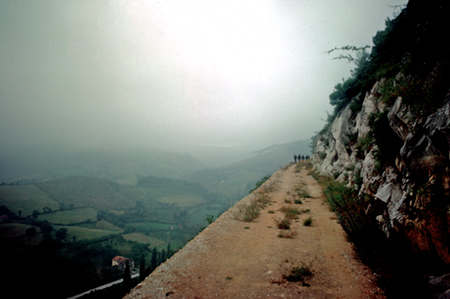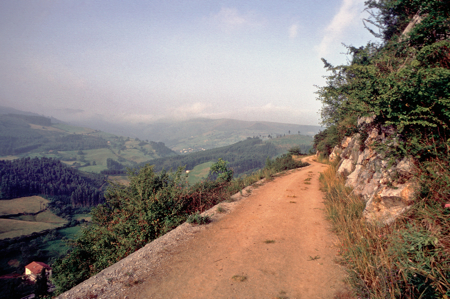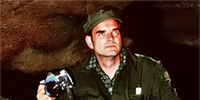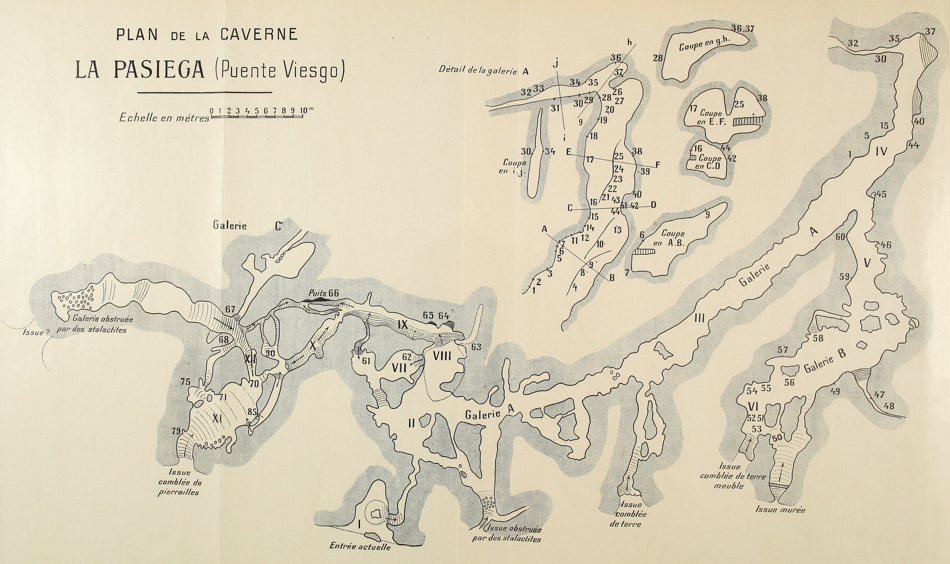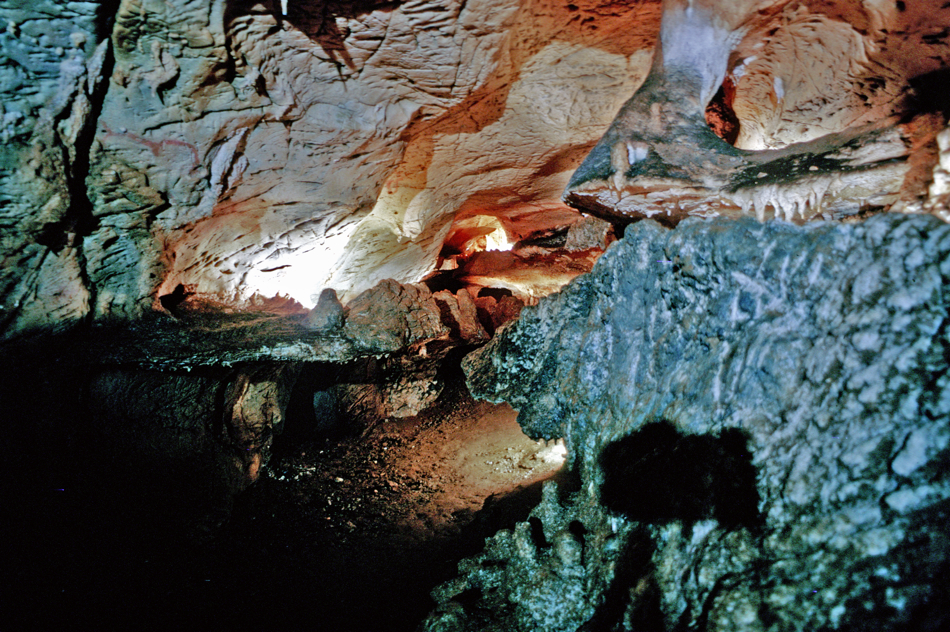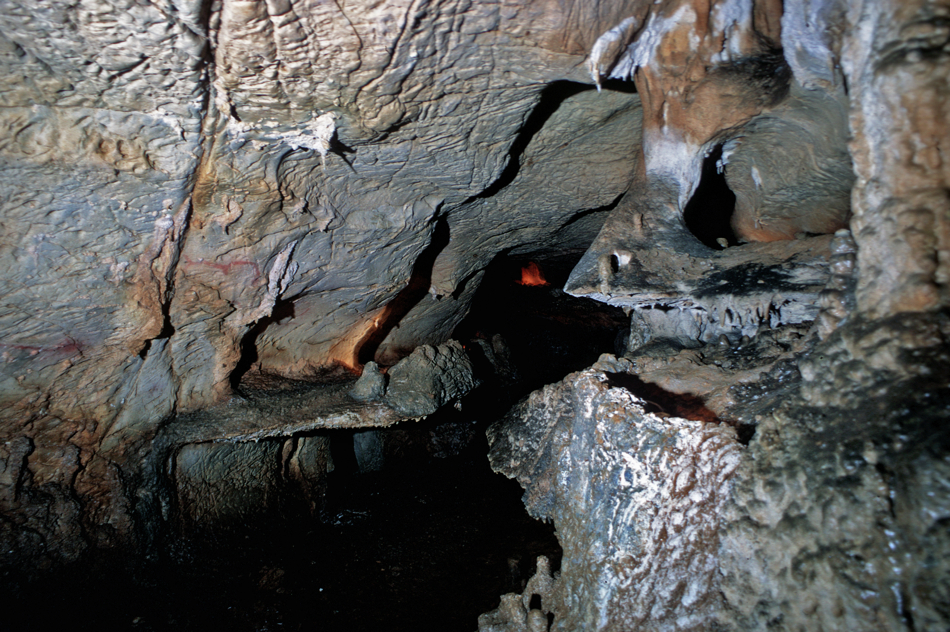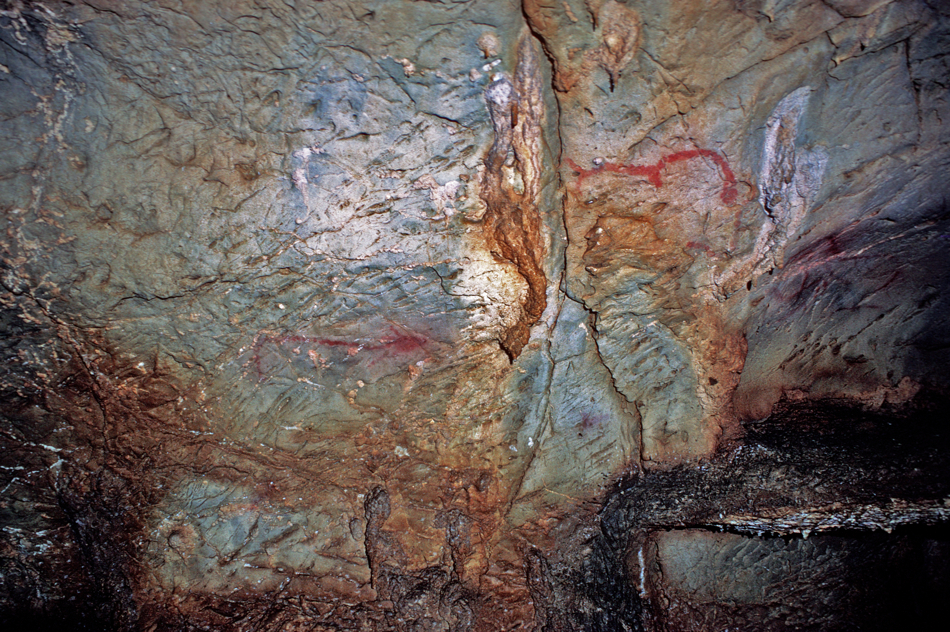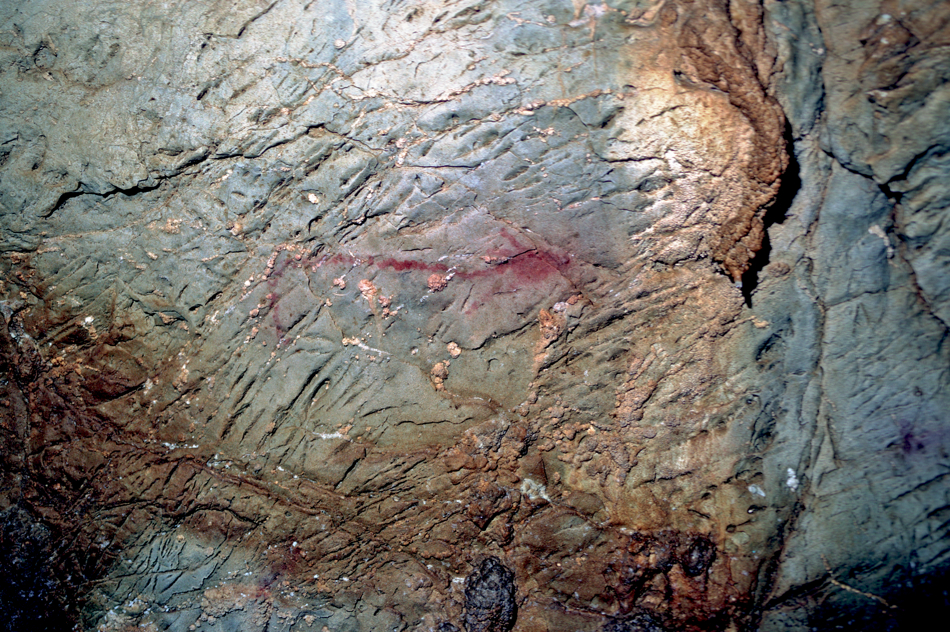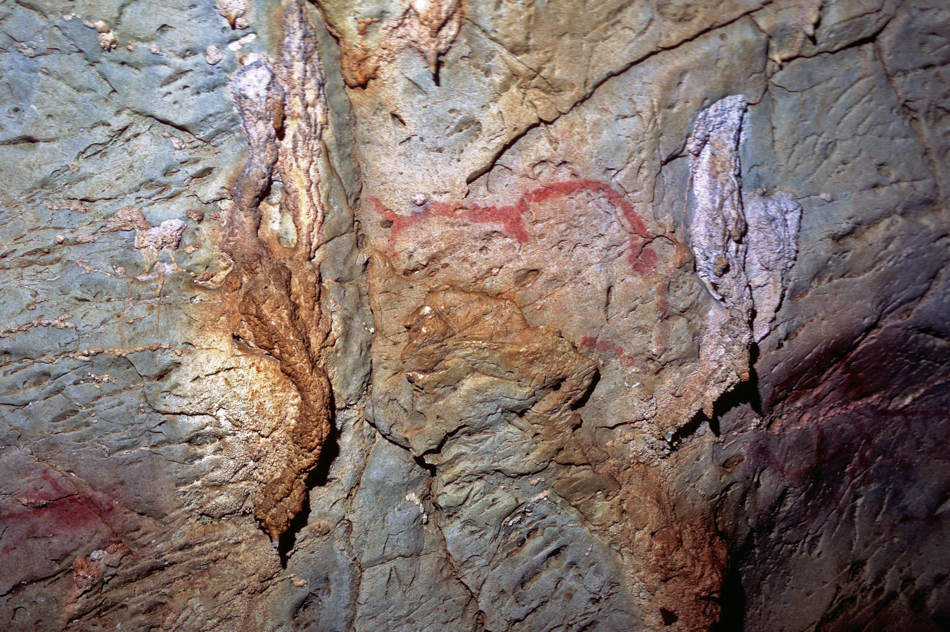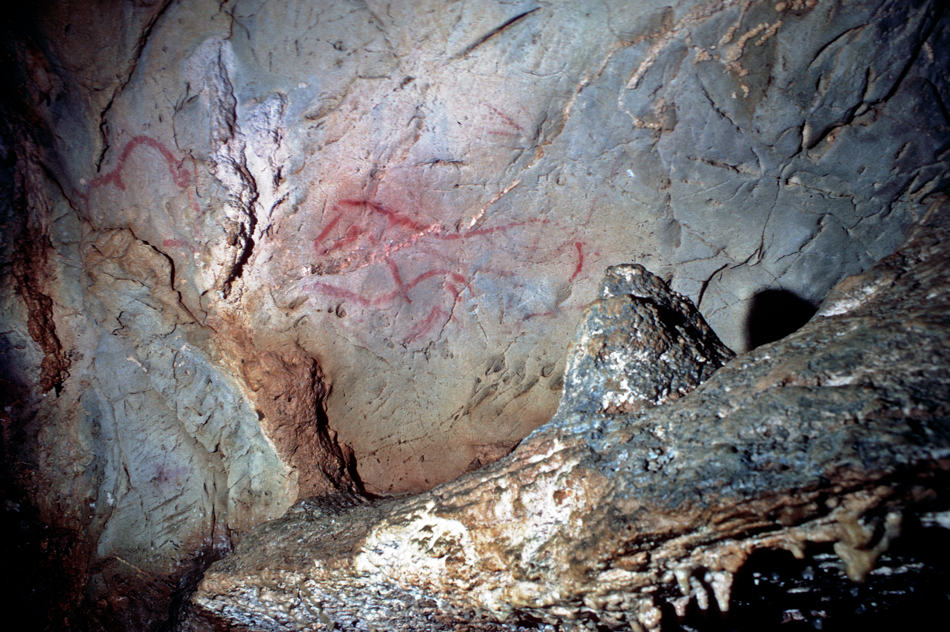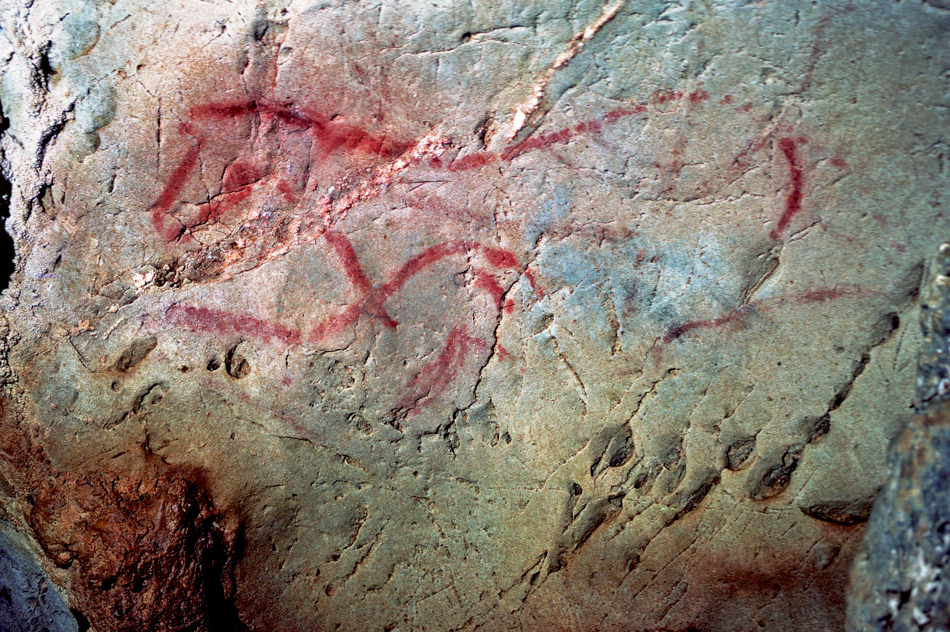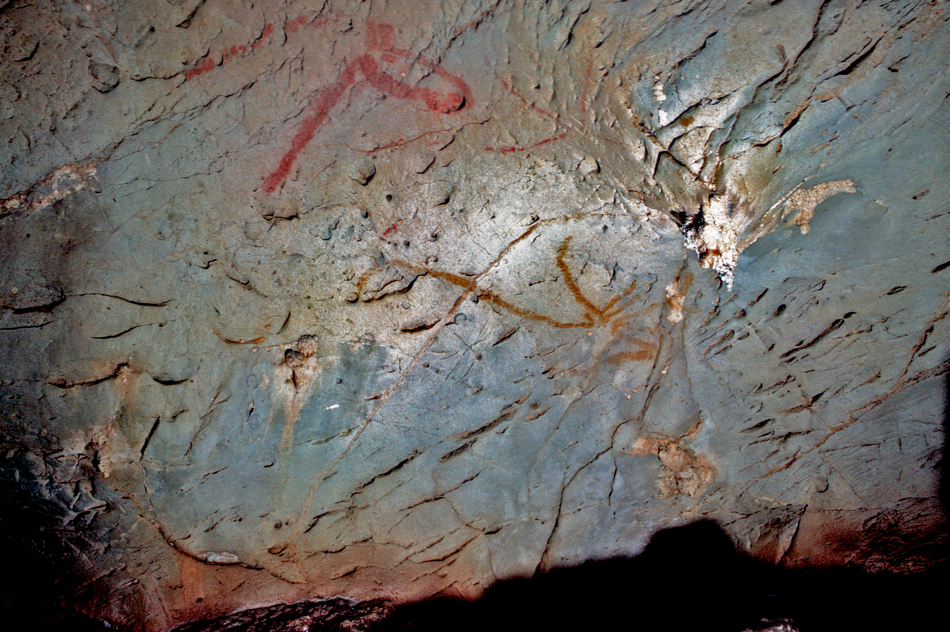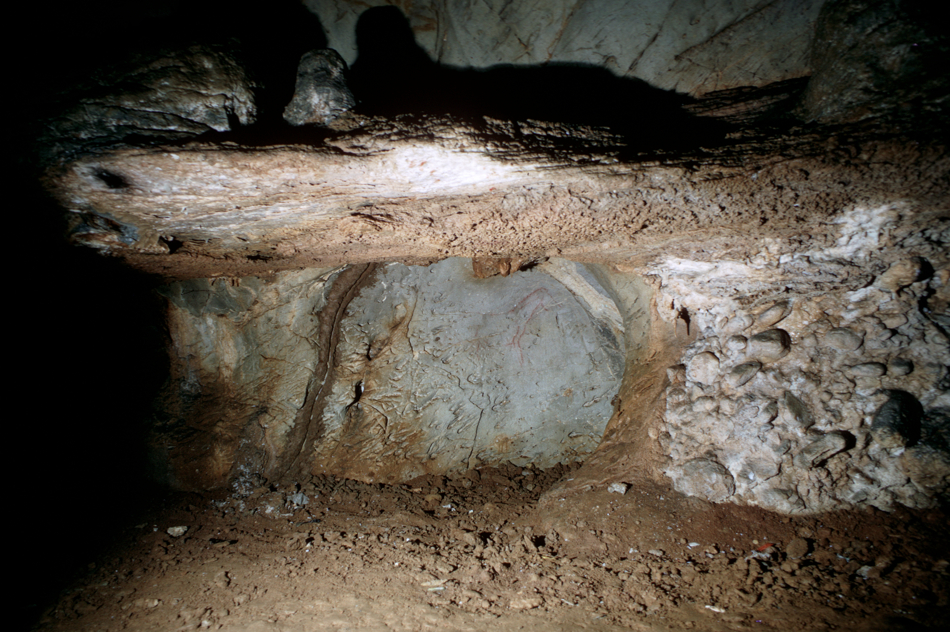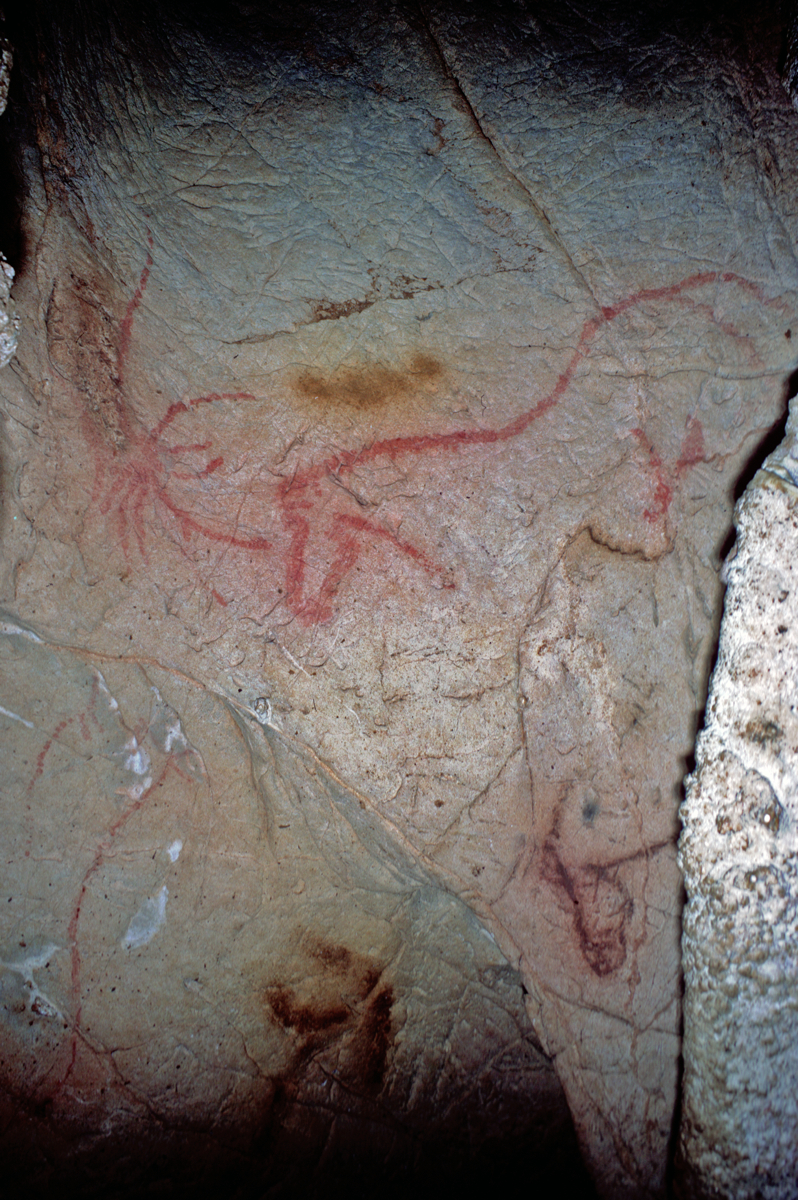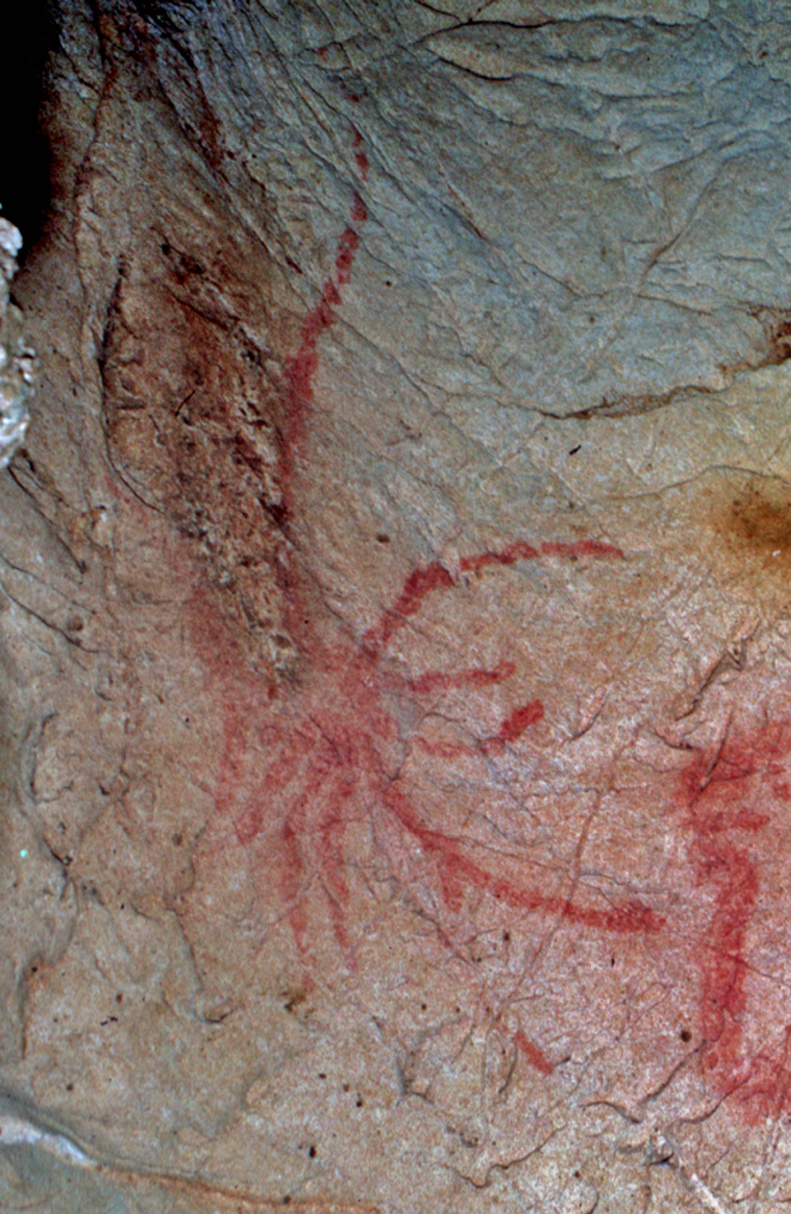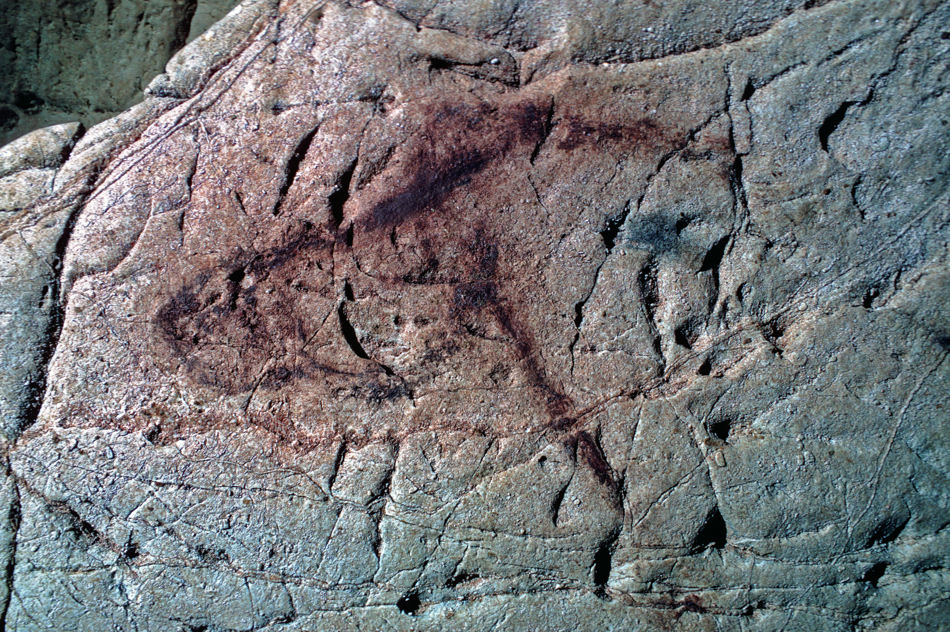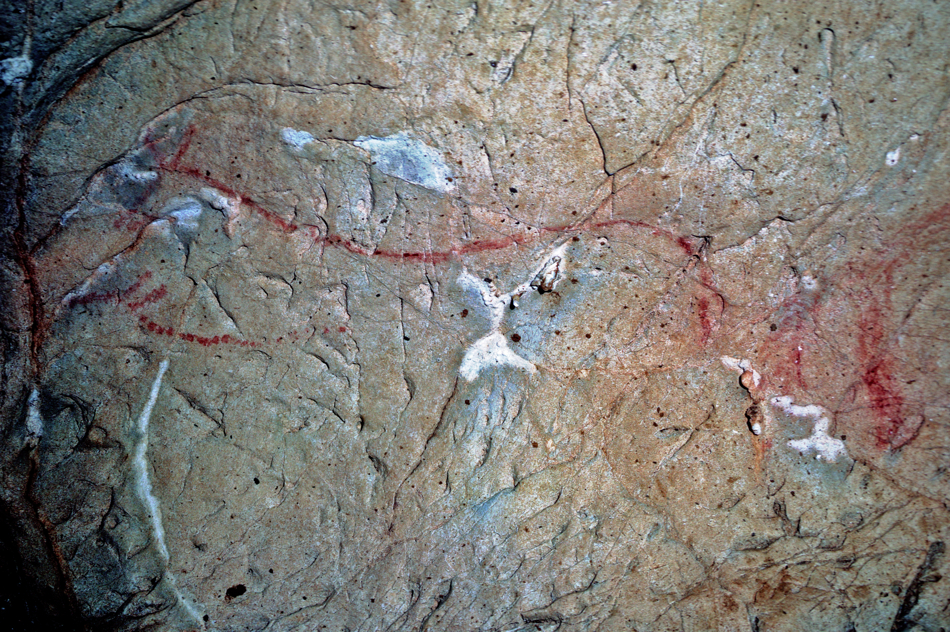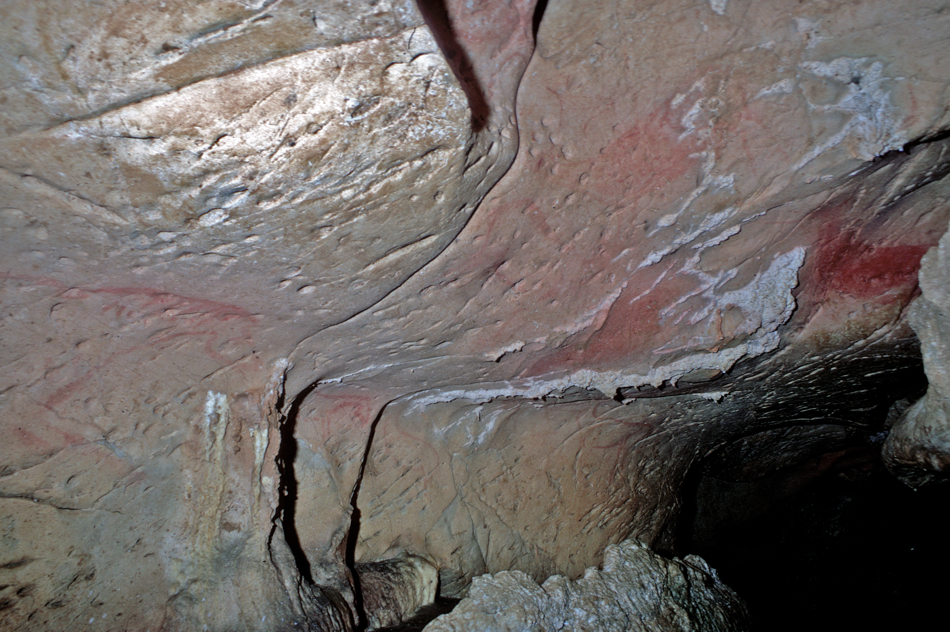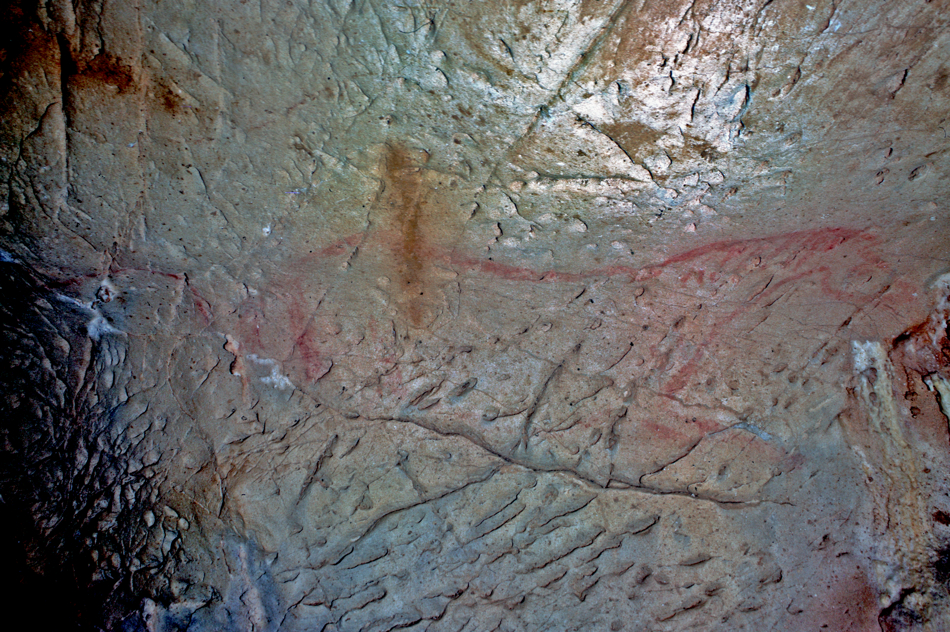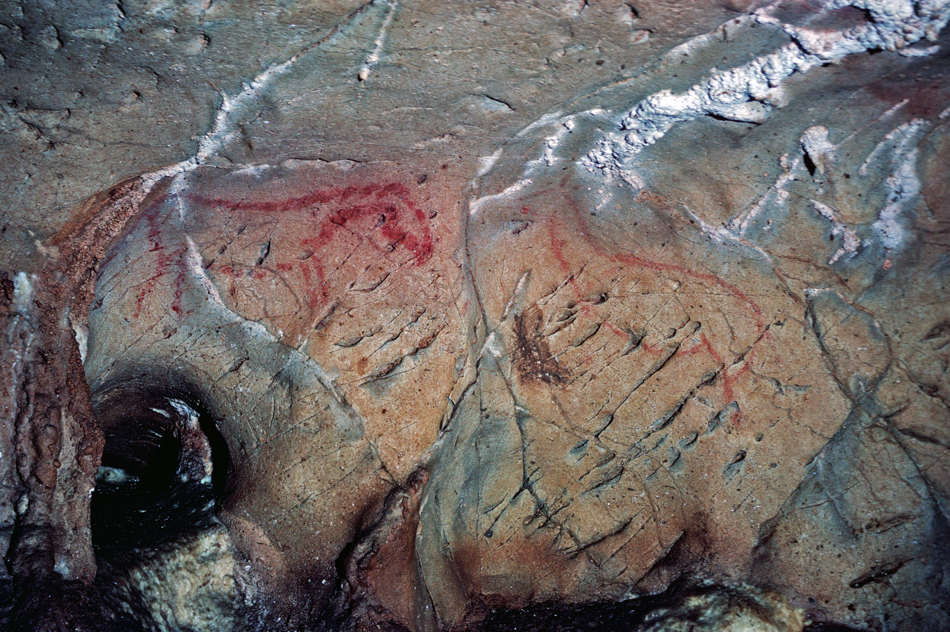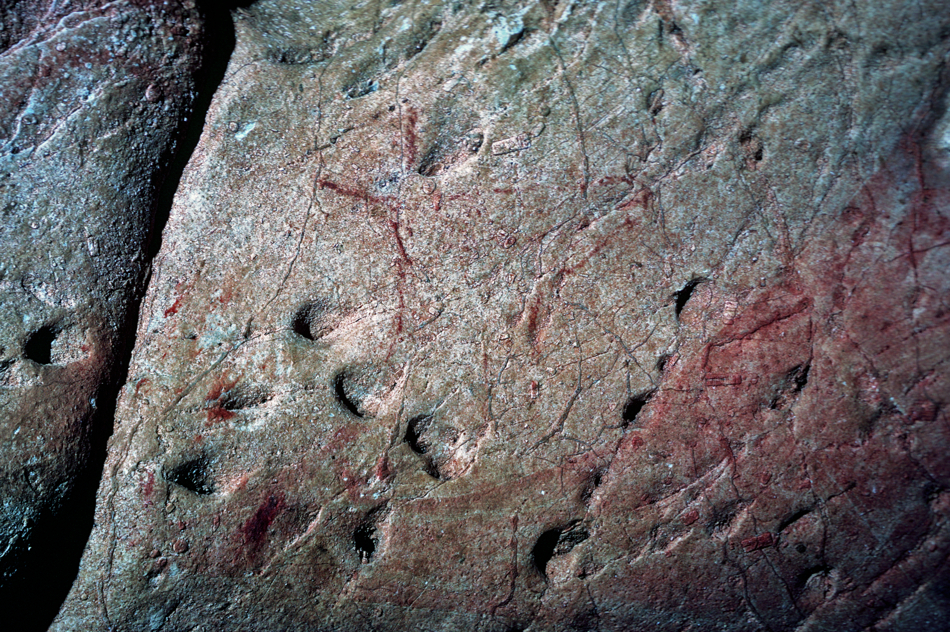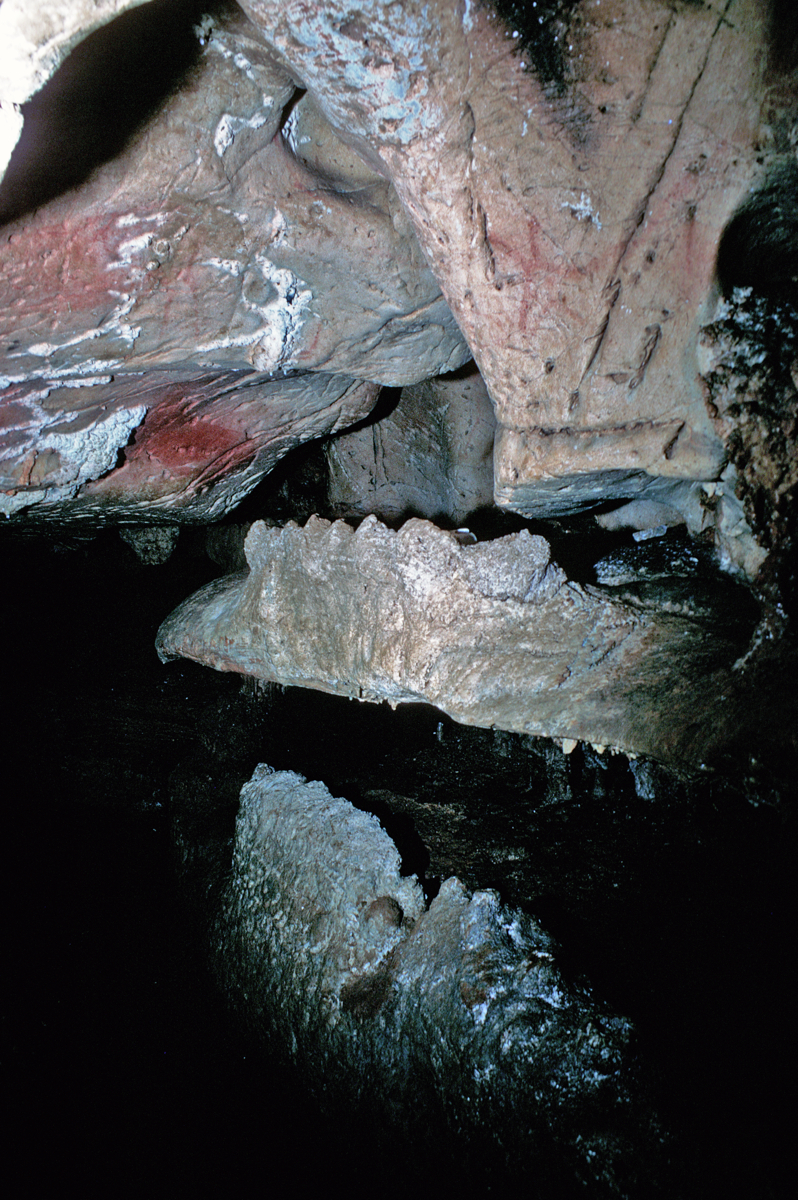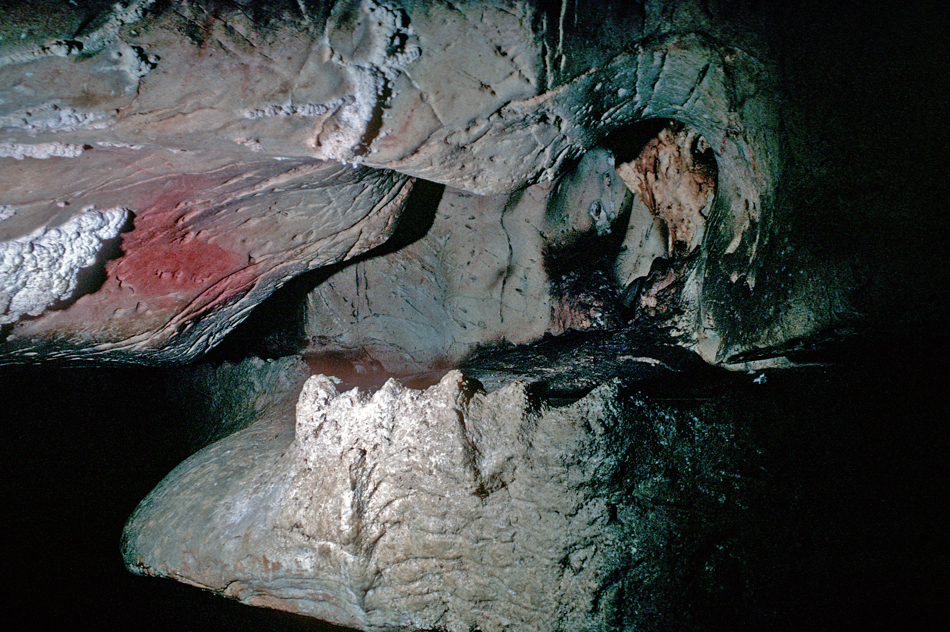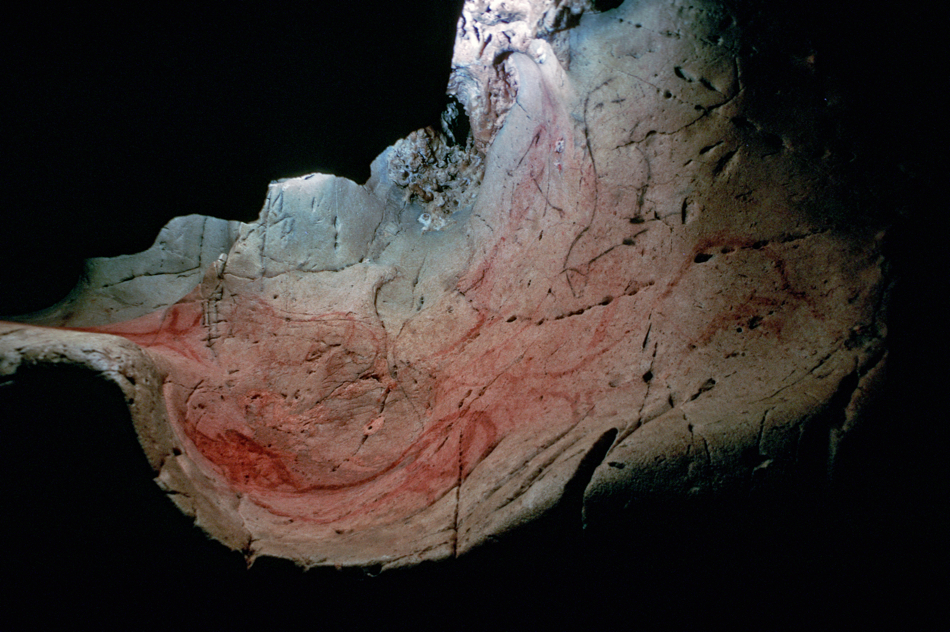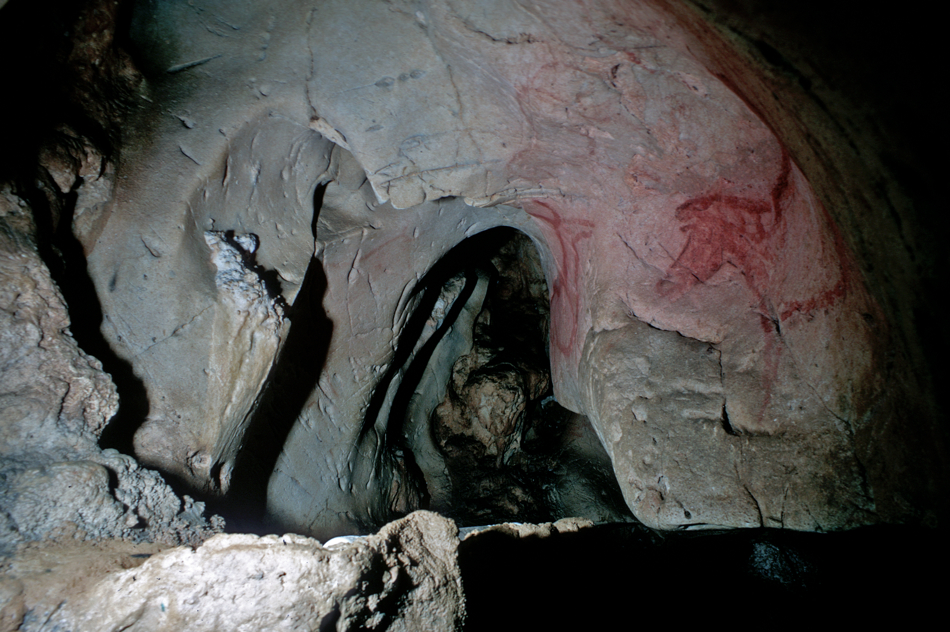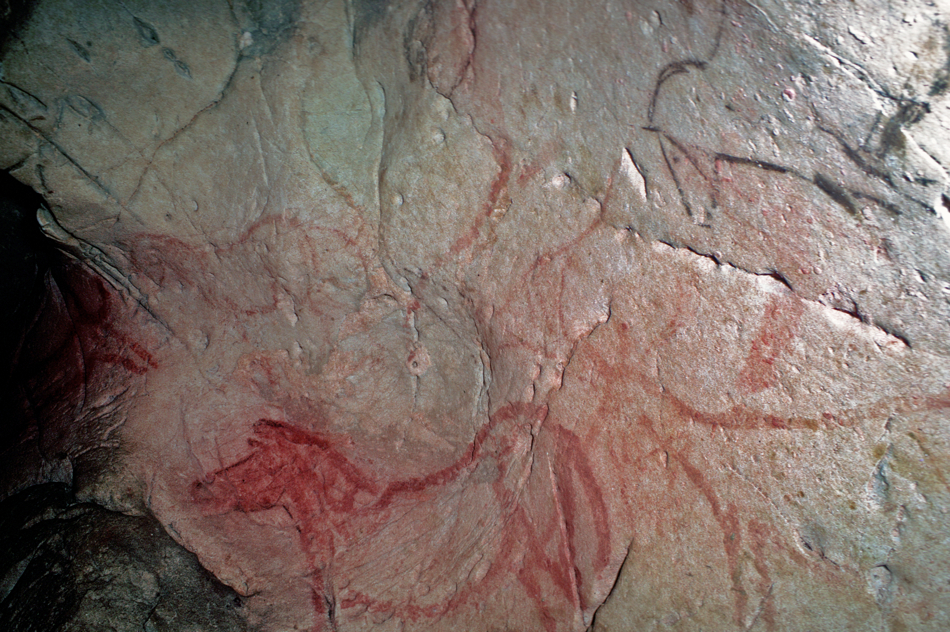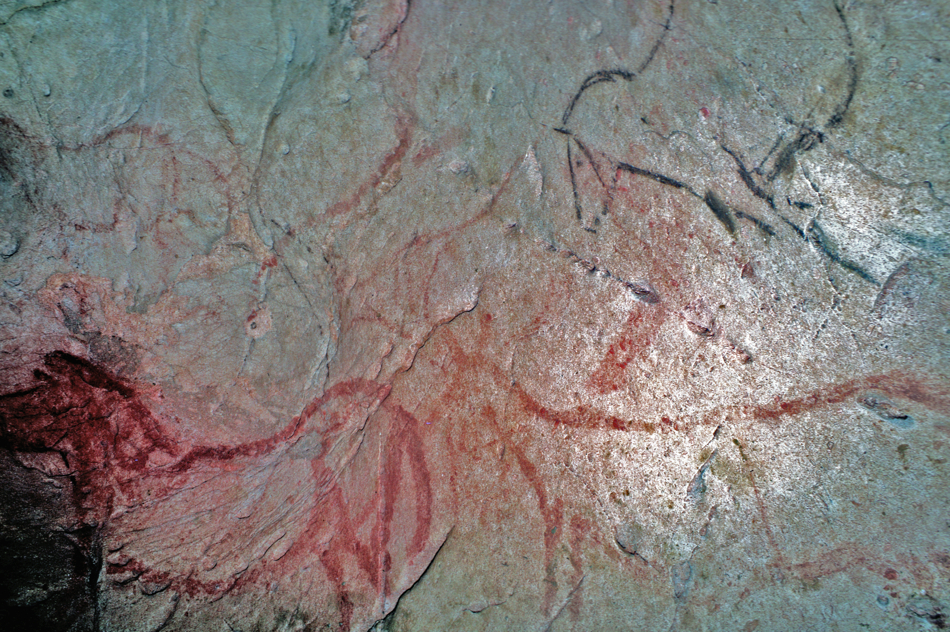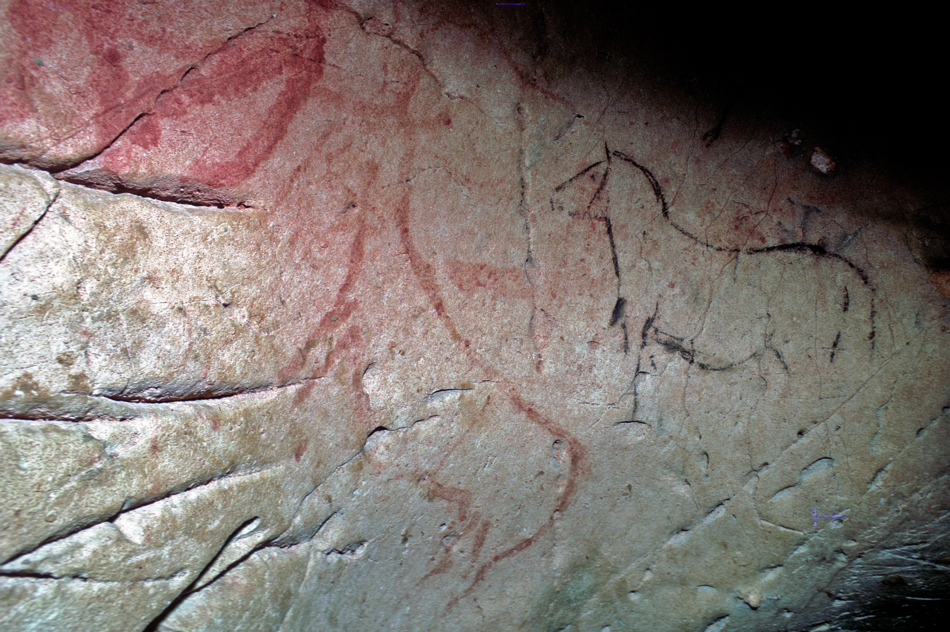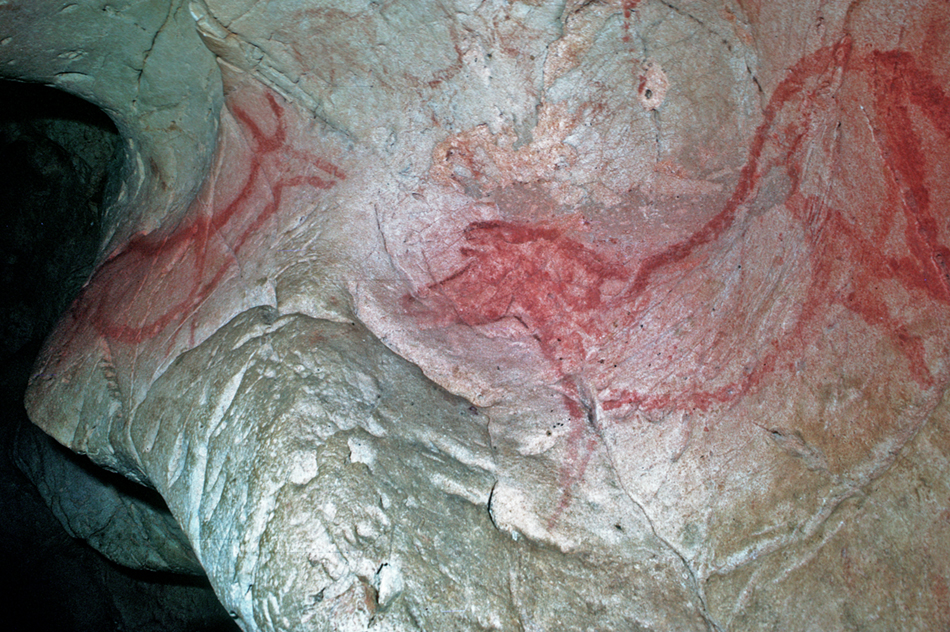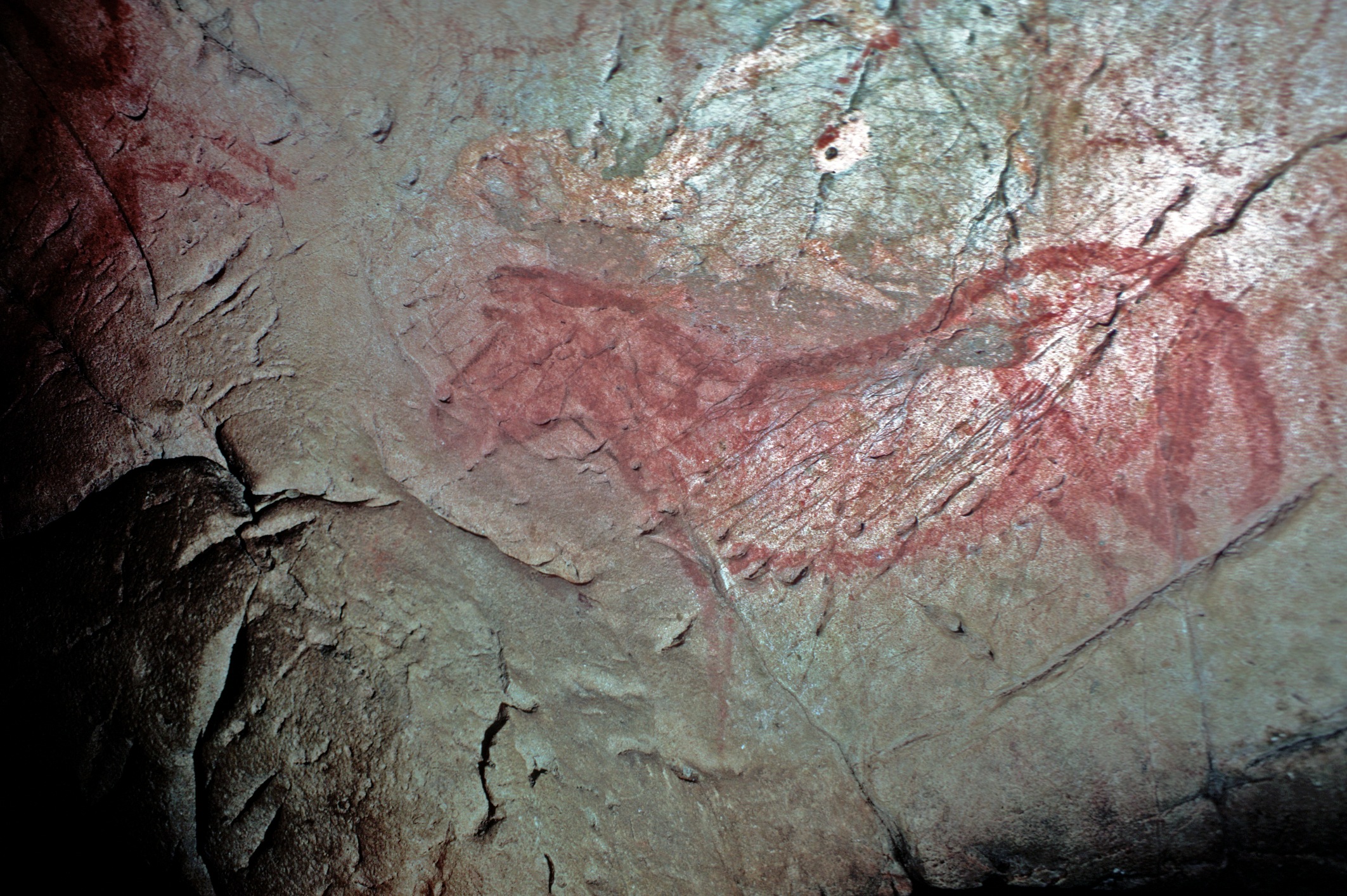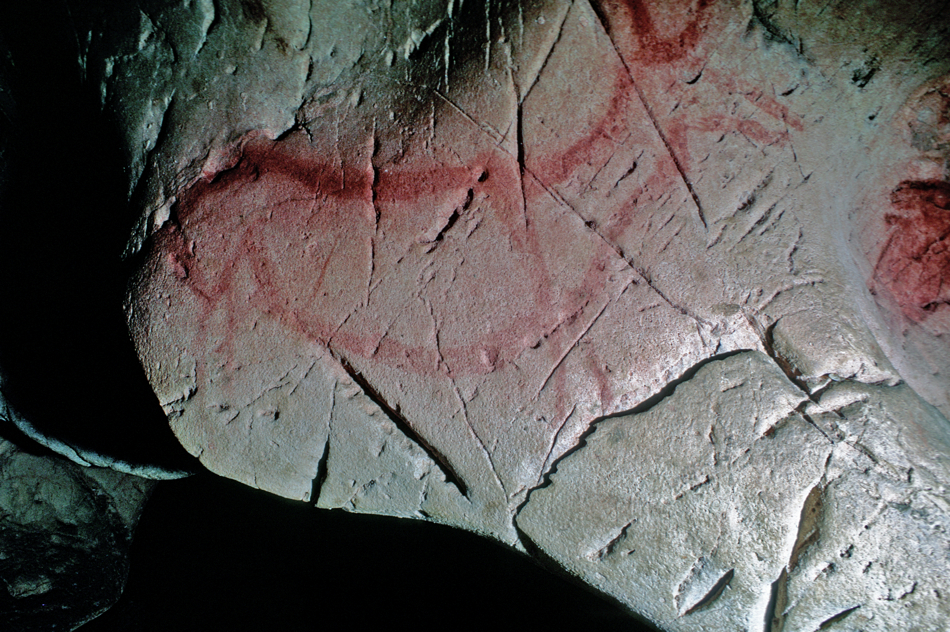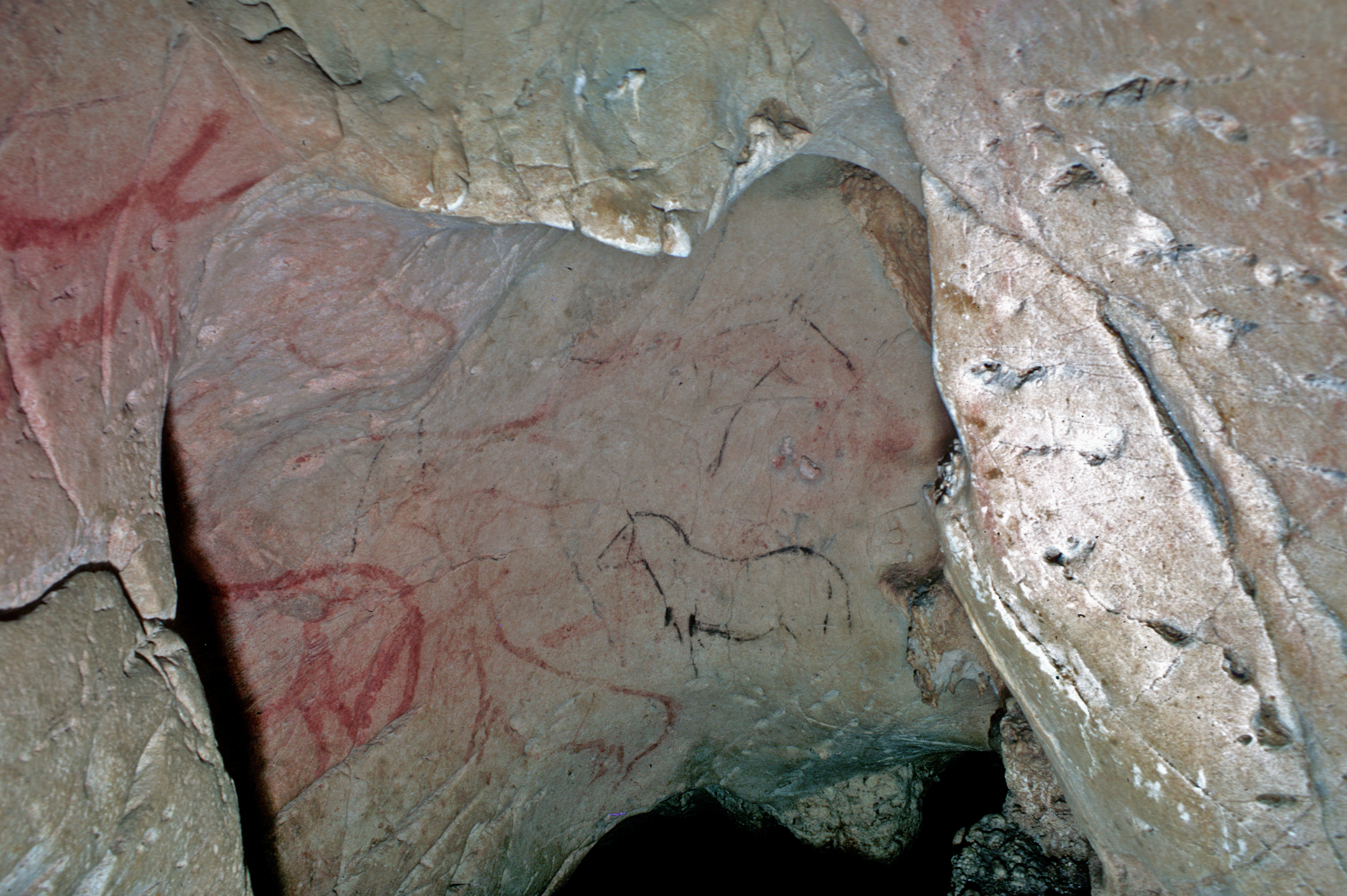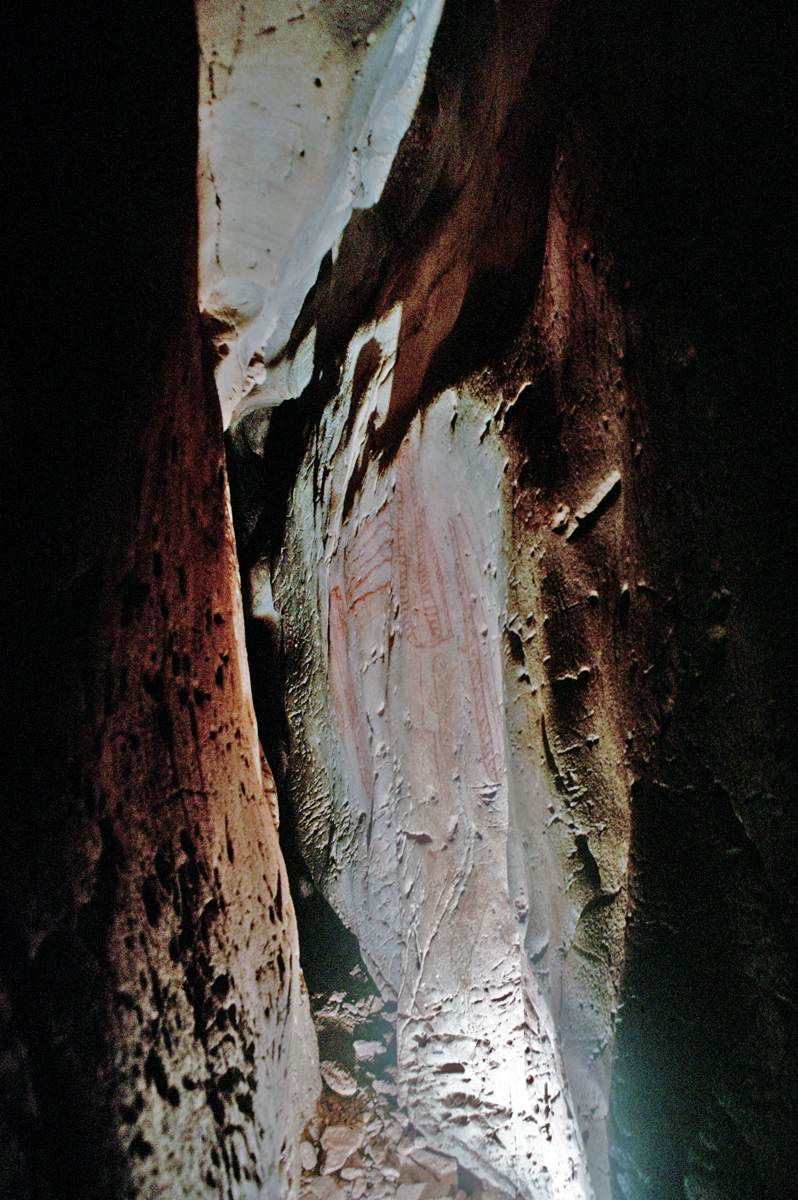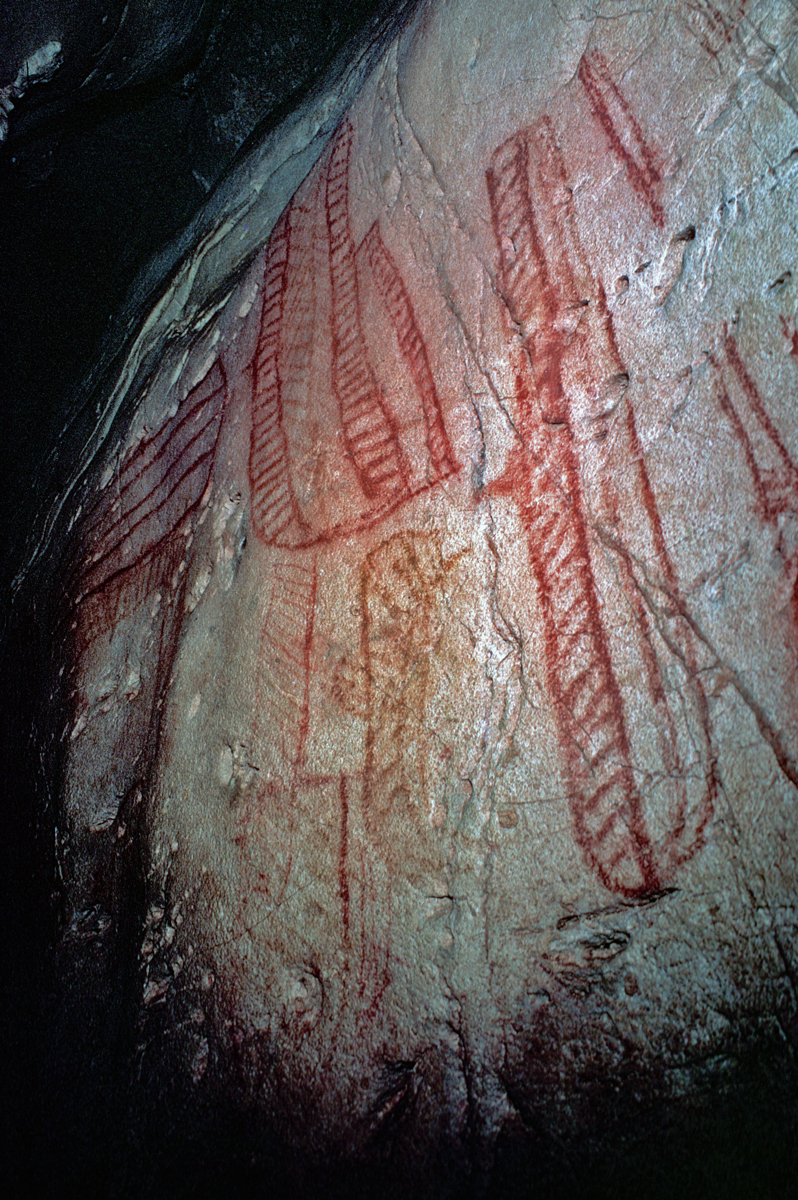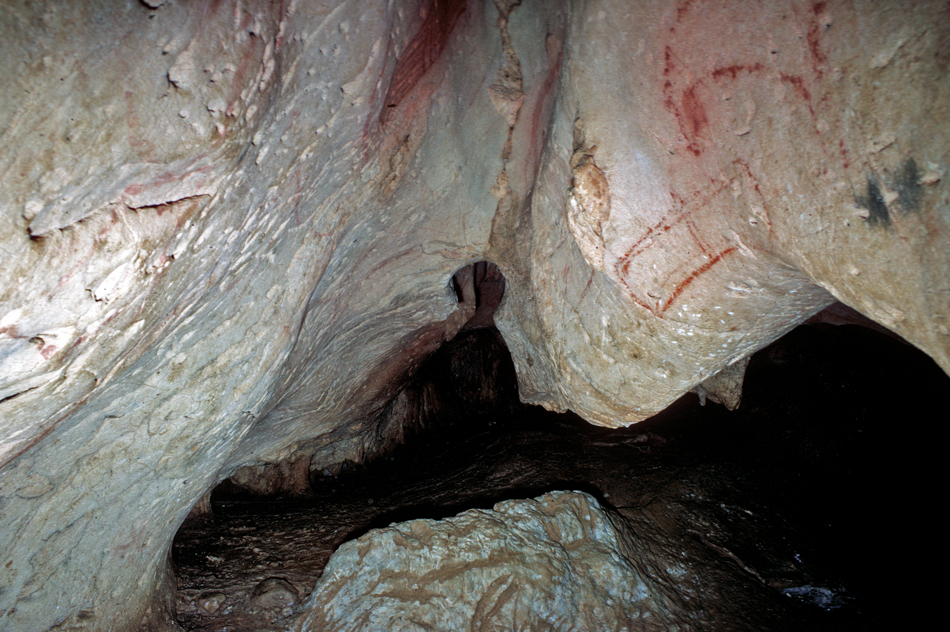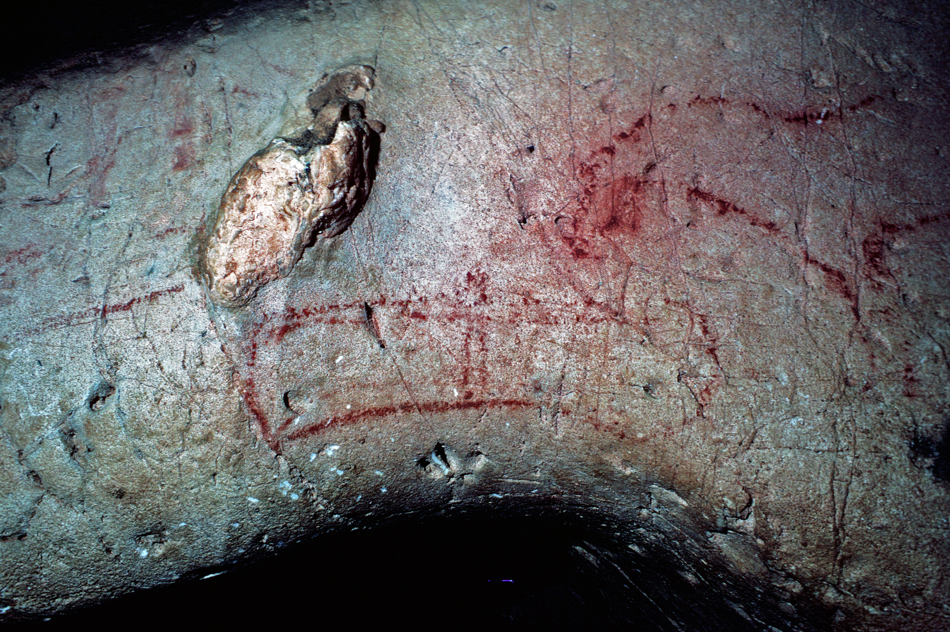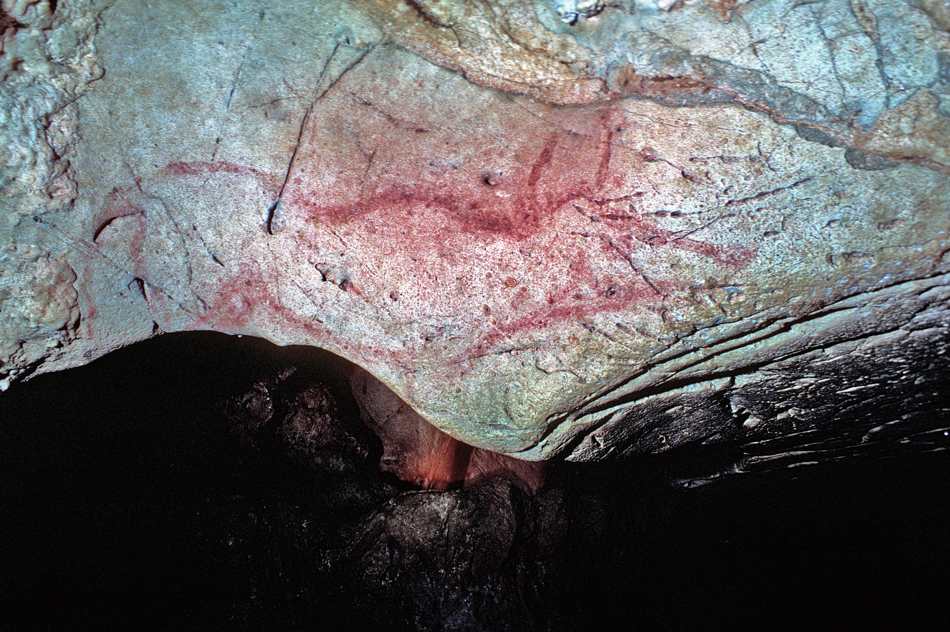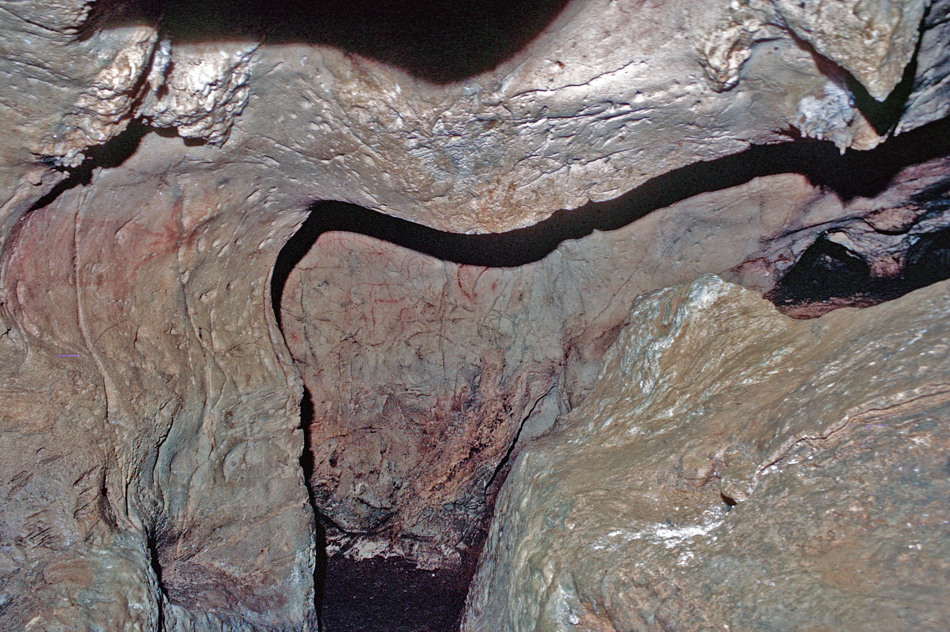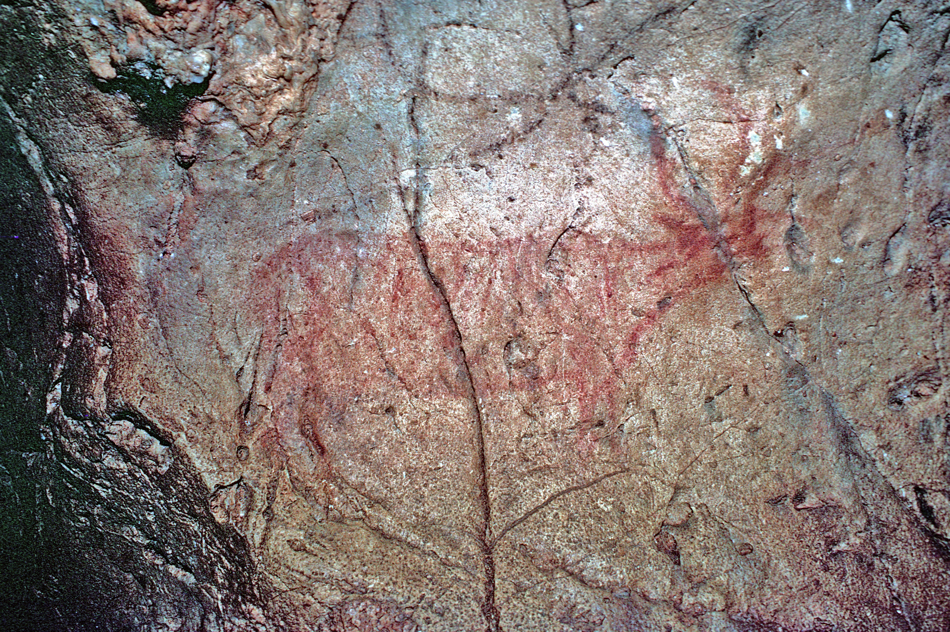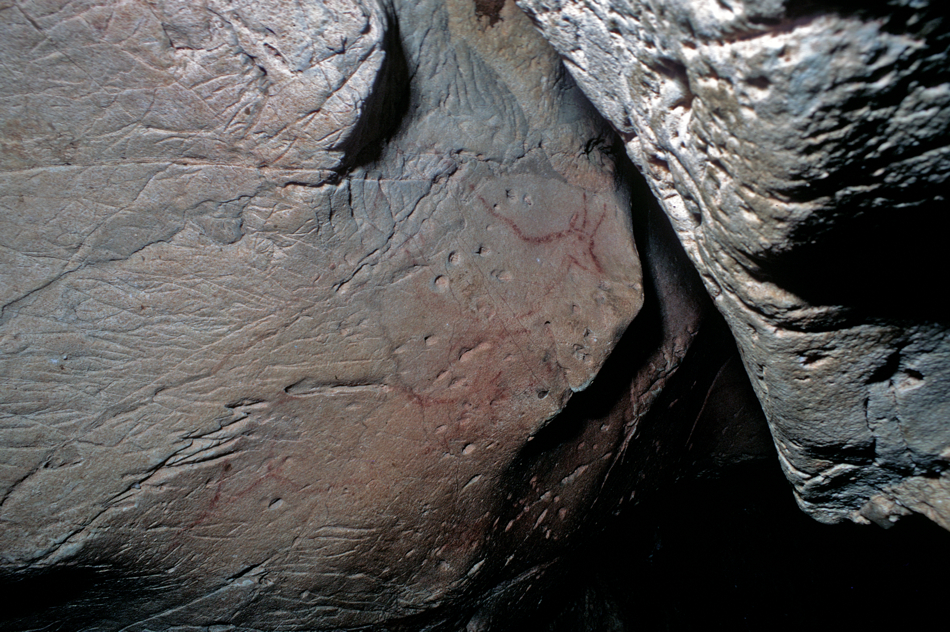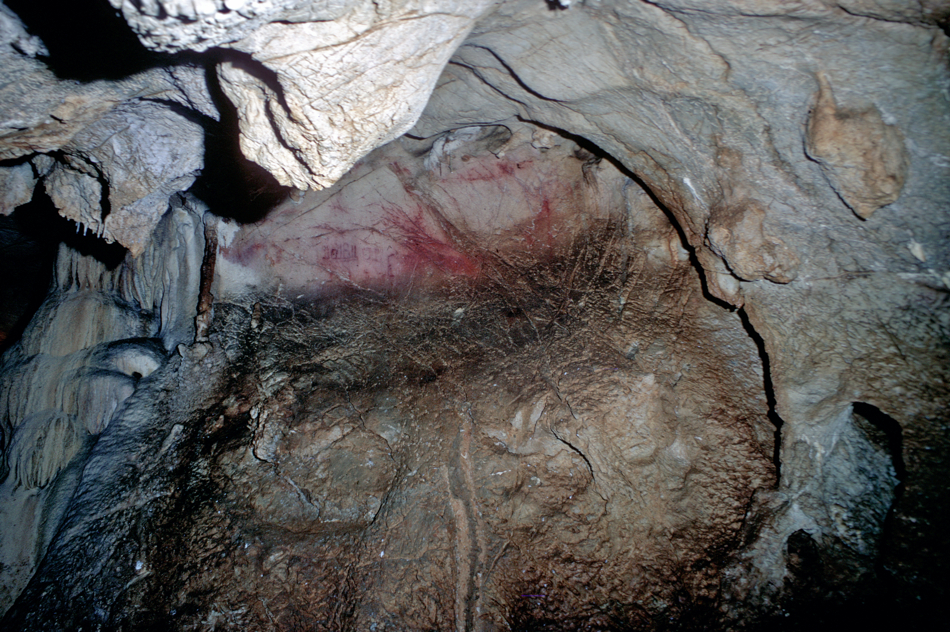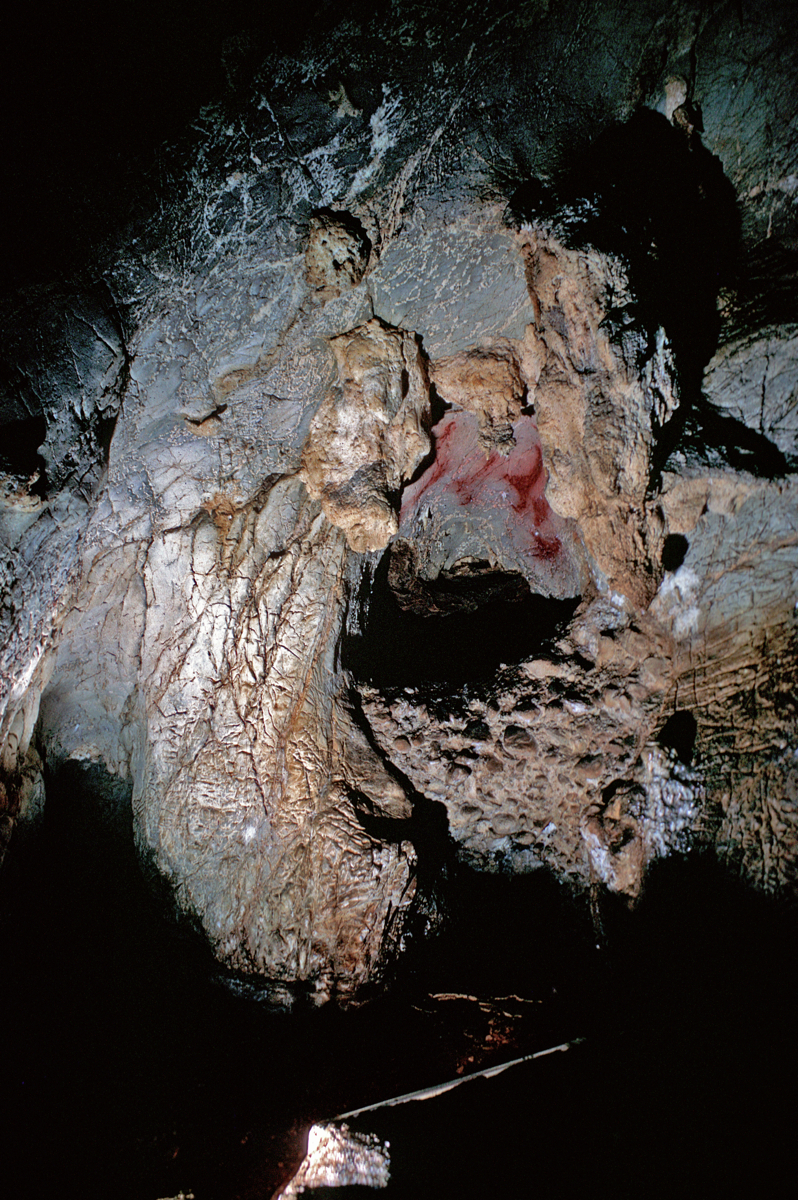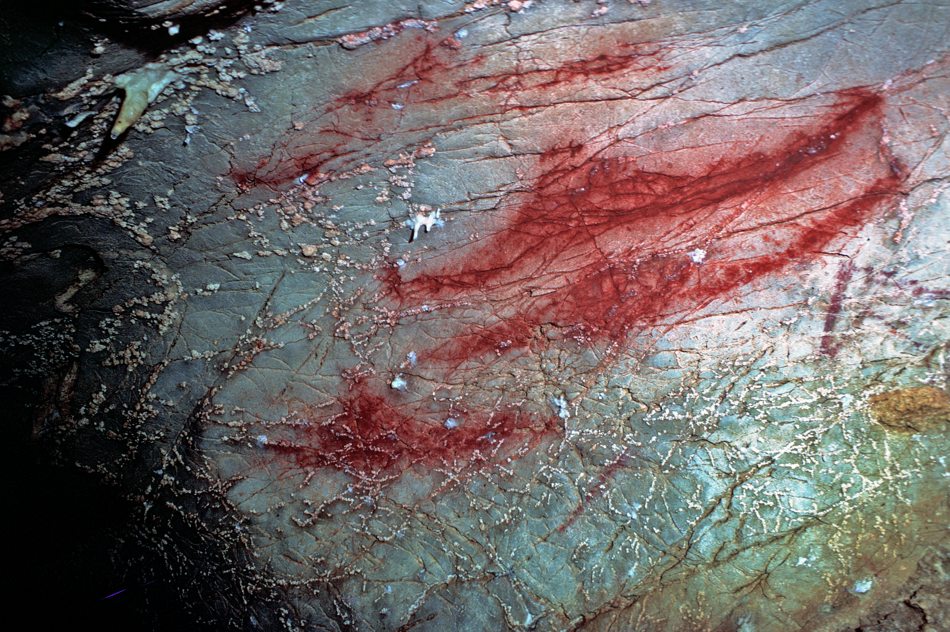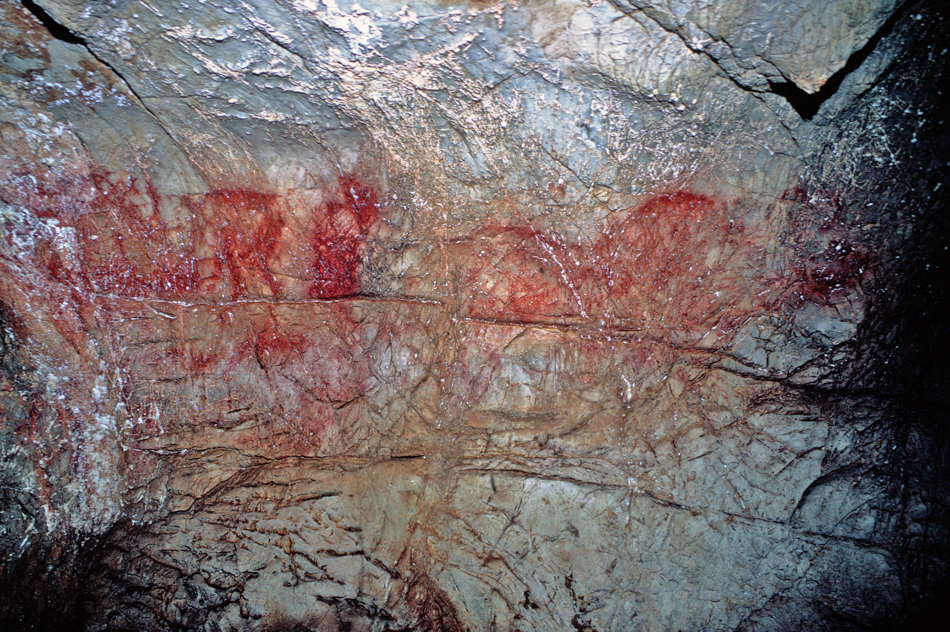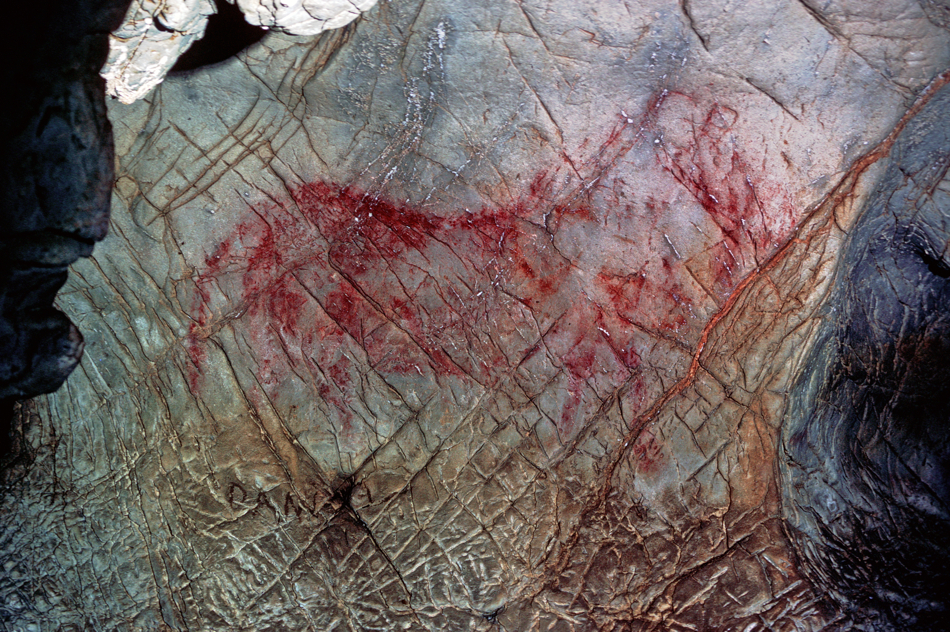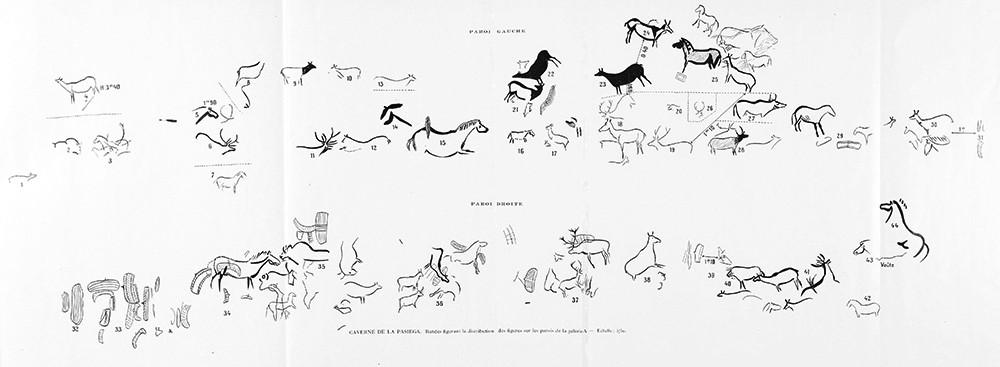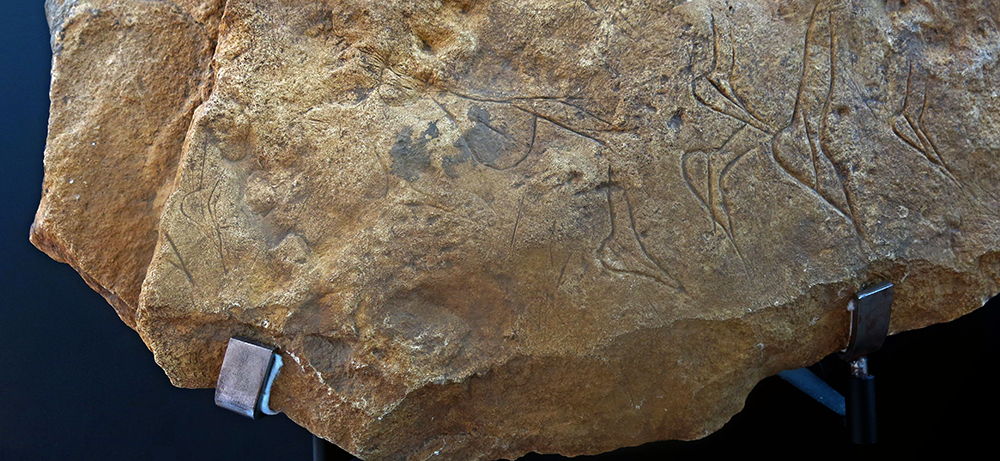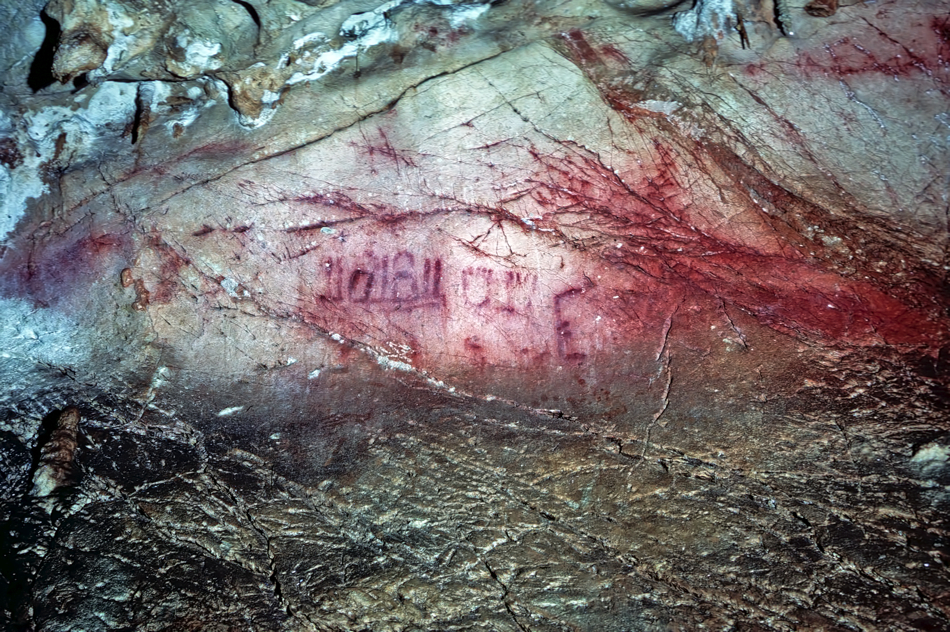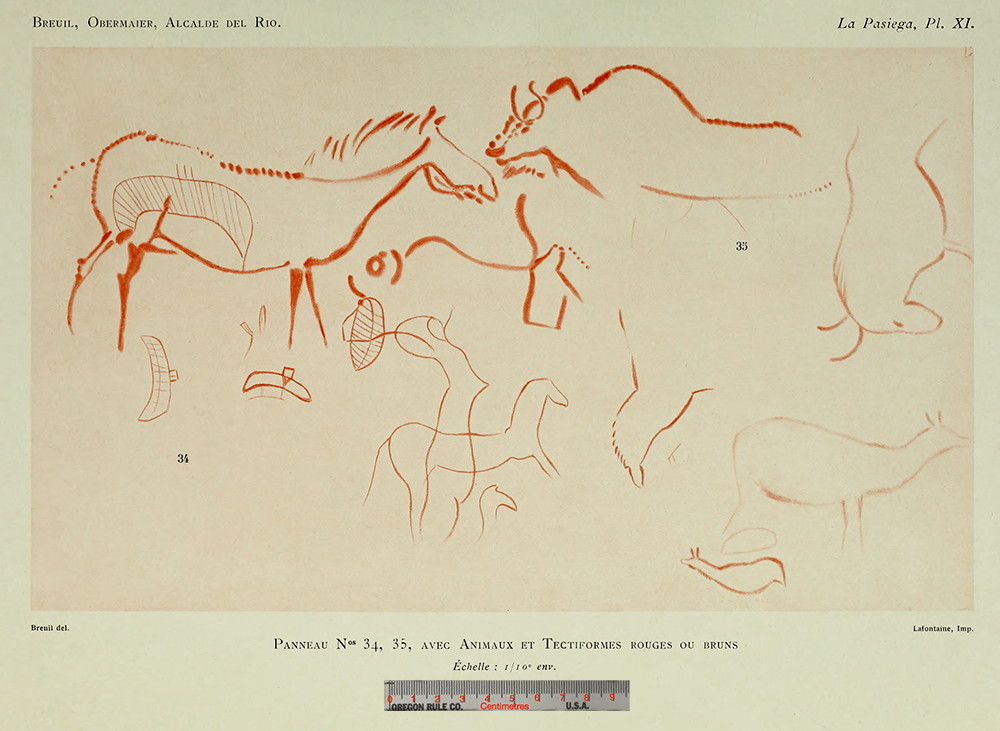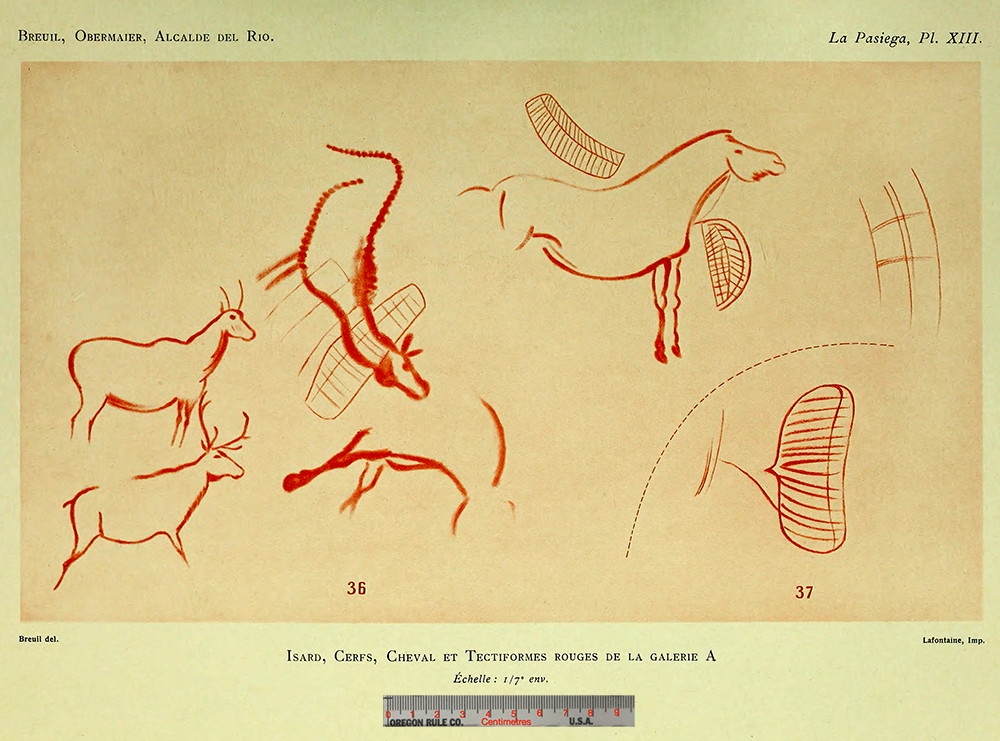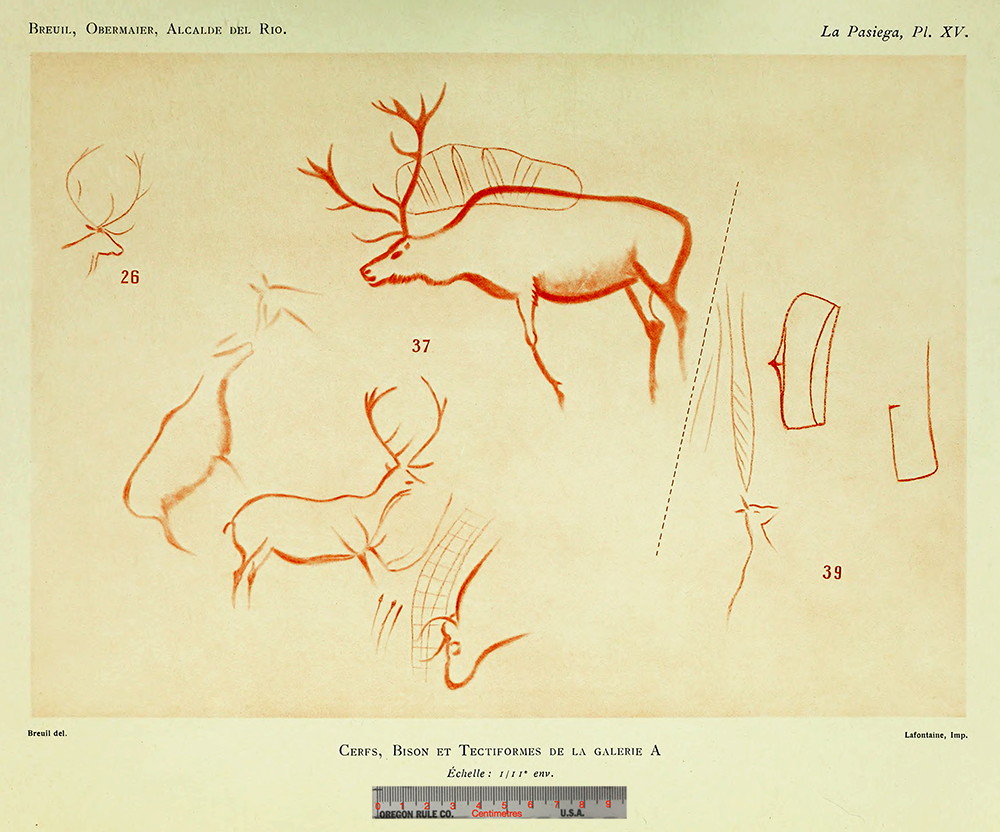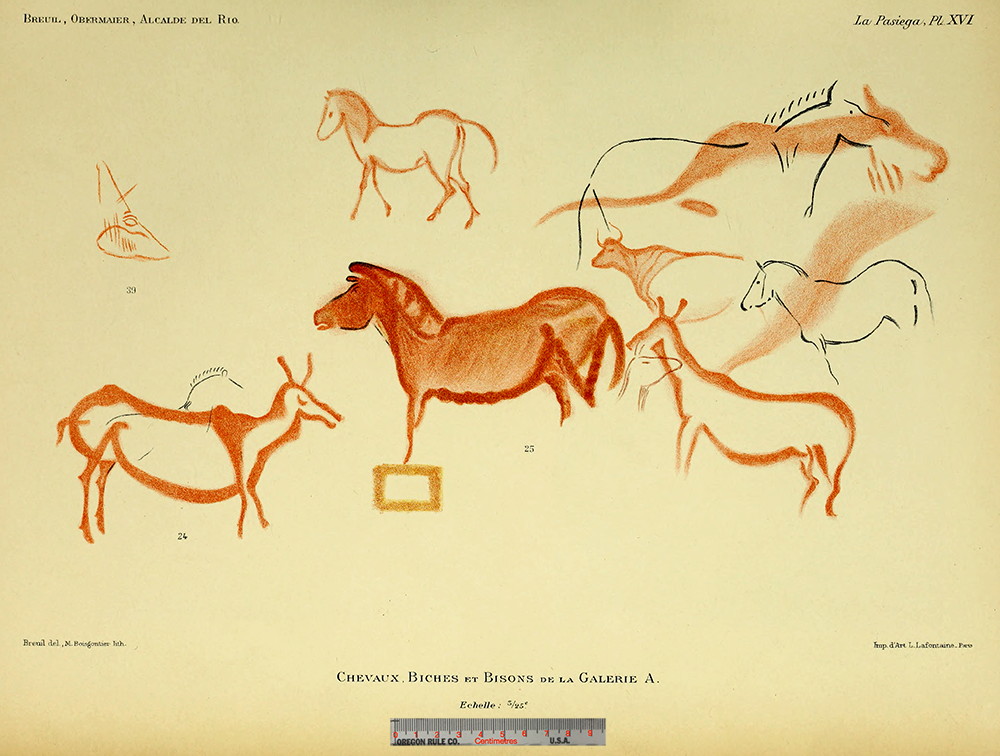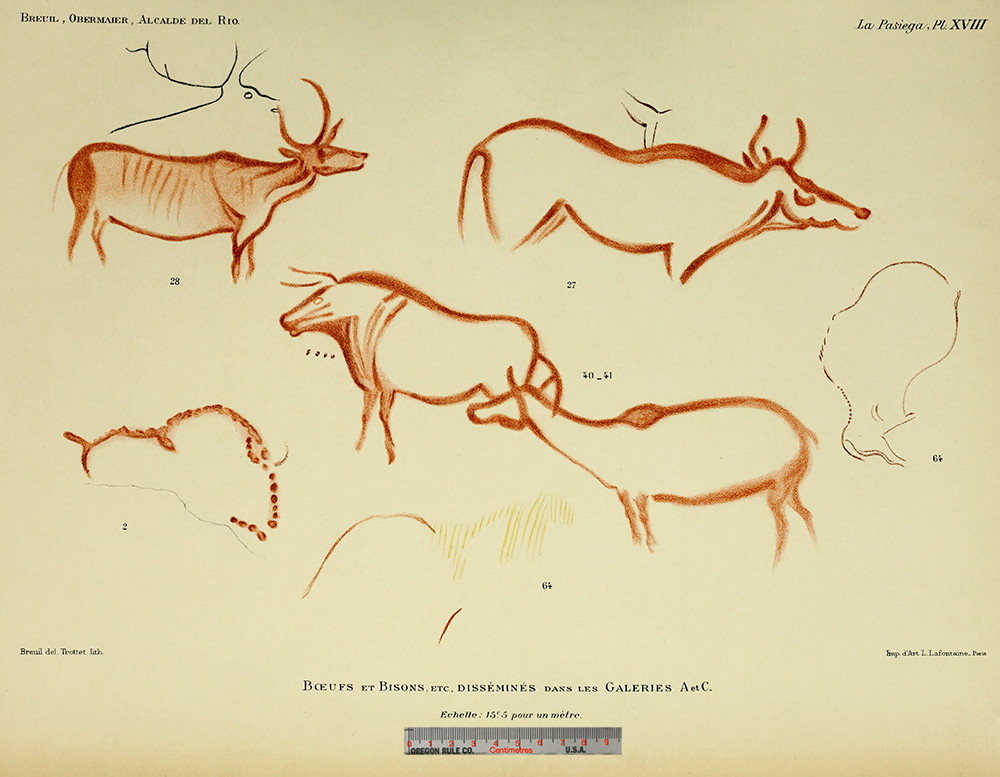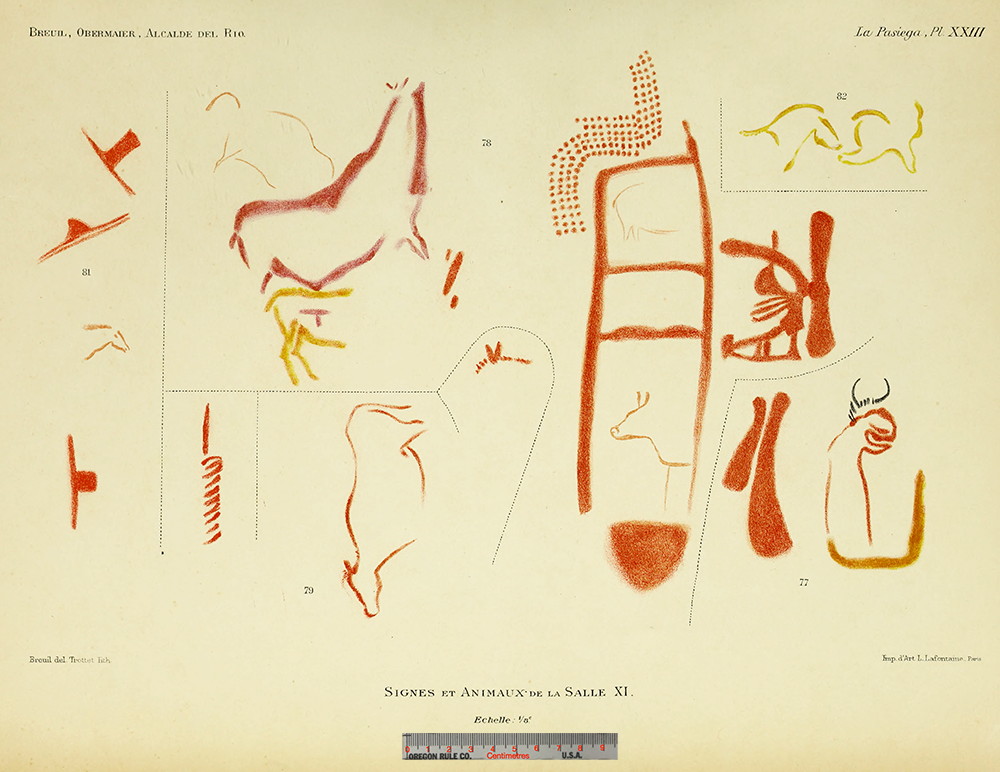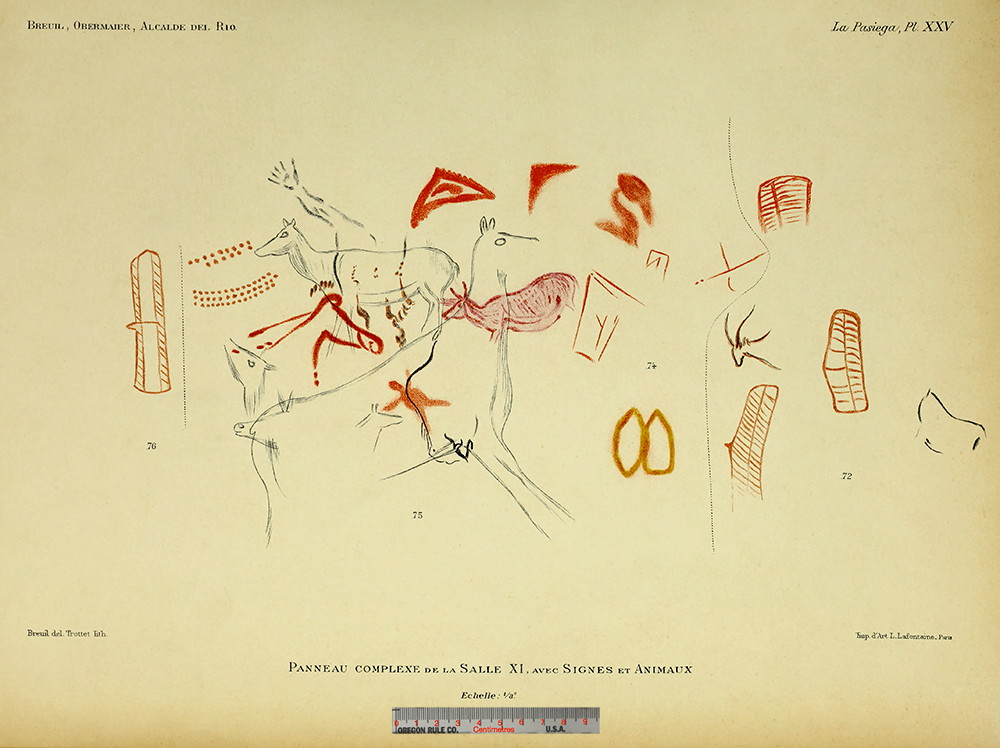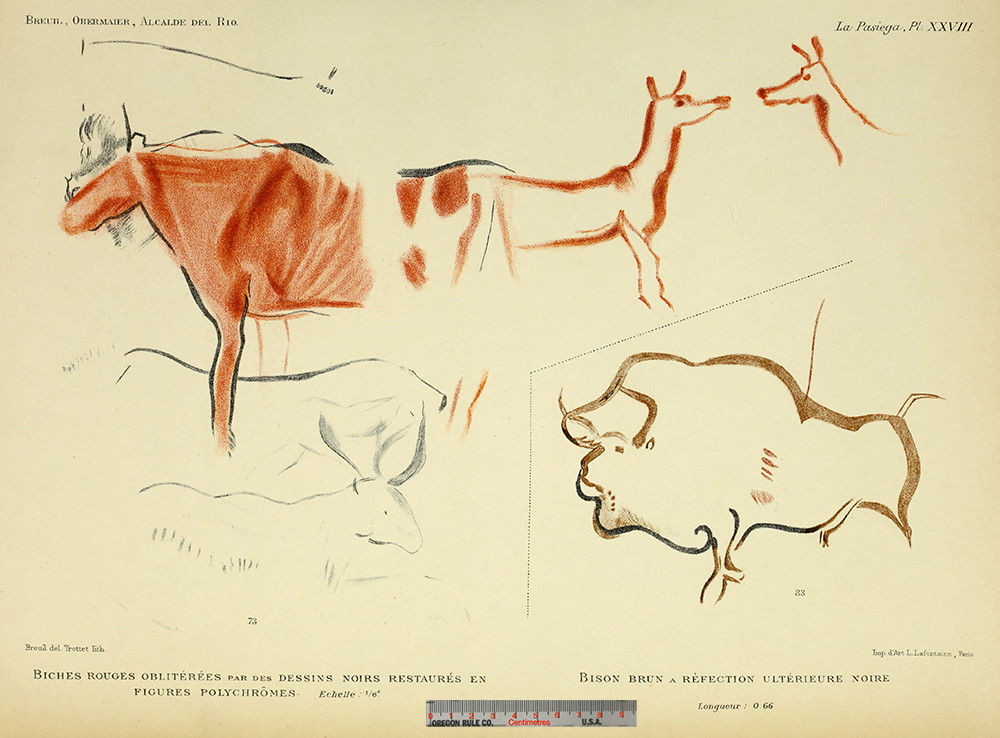Back to Don's Maps
 Back to Archaeological Sites
Back to Archaeological Sites
Pasiega Cave
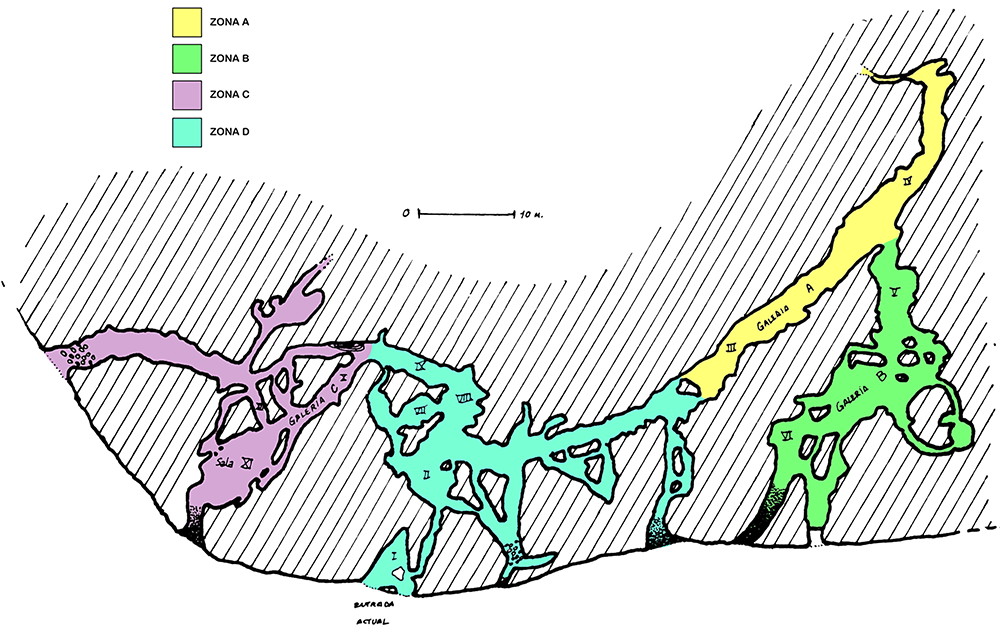
Plan of La Pasiega cave in Spain
Photo: José-Manuel Benito Álvarez —> Locutus Borg
Permission: GNU Free Documentation License, Version 1.2

Valley of the Rio Pas at Puente Viesgo, Spain.
Over half way up the farther side of the prominent peak is the cave of La Pasiega and a little lower down on the side facing the river (within view) is the famous Castillo cave and grotto where man lived periodically almost from the earliest stone age down close to historic times.
Photo and text: Dickson (1915)
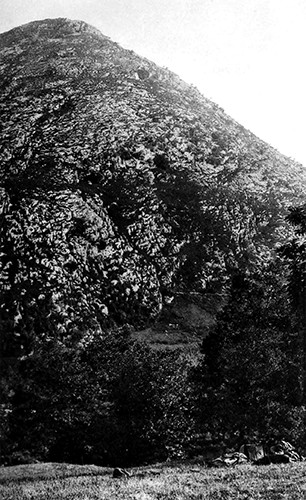
Plate I.
Outside La Pasiega.
The slope of Picacho, where the entrance to La Pasiega may be found.
Photo: Obermaier, in Breuil et al. (1913)
The road to La Pasiega is shown here clinging to the cliff side. Though the road appears well made, guard rails would have improved it greatly, and it would have been a difficult situation if another car were to come in the opposite direction!
Guard rails are now evident on a recent image from Google Earth.
Photo: Heinrich Wendel (© The Wendel Collection, Neanderthal Museum)
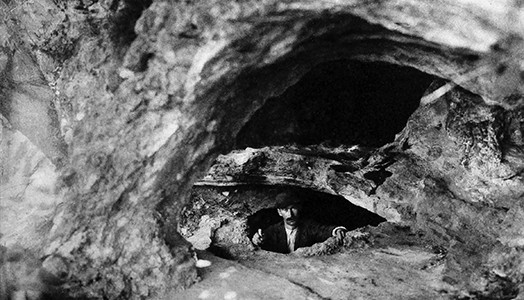
Plate I.
Entrance to La Pasiega circa 1911.
The man in this photograph is Alejandro Mena Garay, right hand man of Obermaier and chief of the Spanish digging workers. He holds a candle in his hand, emerging from the cave.
( My sincere thanks for this useful identification to Alejandro Mena Campuzano, his great grandson, p.c. - Don )
Photo: Obermaier, in Breuil et al. (1913)
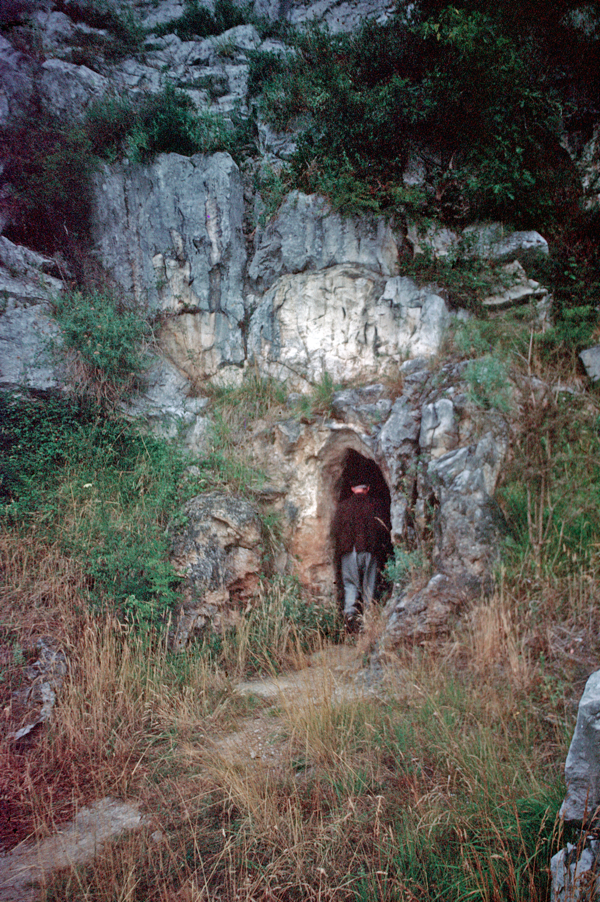
The entrance to the cave.
Photo: Heinrich Wendel (© The Wendel Collection, Neanderthal Museum)

Entrance to La Pasiega in August 2016.
( comparison with the two photographs above shows that the entrance has been enlarged to permit easier access, but not excessively so - Don )
Photo: © Carmen F.
Source: Google Maps

La Pasiega cave is one of the caves of Monte Castillo, the locality shown here, in northern Spain.
Photo: Hoffmann et al. (2018)
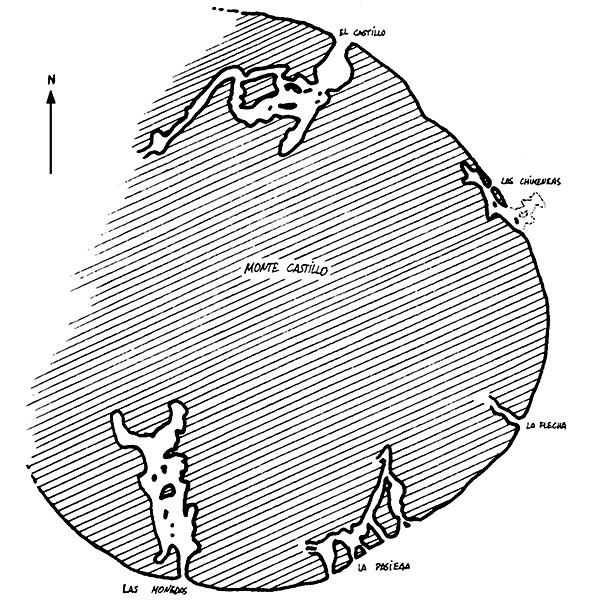
Map of the El Castillo complex of limestone caves in which Cueva de La Pasiega is located.
Photo: Hoffmann et al. (2018)
Satellite photograph from Google Earth of the El Castillo site.
The view has been tilted to indicate the local relief, with the cave complex on the limestone hill of Monte Castillo.
Photo: Google Earth
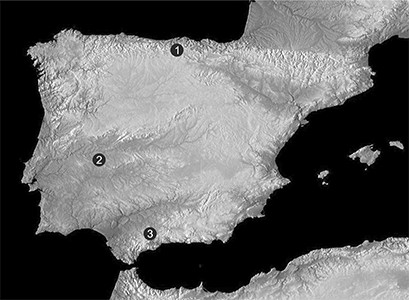
Map of the Iberian Peninsula. The dots indicate the locations of three important cave sites.
1: La Pasiega
2: Maltravieso
3: Ardales
Photo: Hoffmann et al. (2018)
Plan of La Pasiega, 1913.
Photo: Breuil et al. (1913)
The interior of the cave, possibly at site II in the map above, looking along Galerie A.
Photo: Heinrich Wendel (© The Wendel Collection, Neanderthal Museum)
Galerie A, cervid(?), bison.
Note the water on the floor.
Photo: Heinrich Wendel (© The Wendel Collection, Neanderthal Museum)
Galerie A, cervid(?), bison, as above.
Photo: Heinrich Wendel (© The Wendel Collection, Neanderthal Museum)
Galerie A, cervid(?), as above.
Photo: Heinrich Wendel (© The Wendel Collection, Neanderthal Museum)
Galerie A, bison, as above.
Photo: Heinrich Wendel (© The Wendel Collection, Neanderthal Museum)
Galerie A, bison, cervid, equids.
Photo: Heinrich Wendel (© The Wendel Collection, Neanderthal Museum)
Galerie A, cervid, equids.
Photo: Heinrich Wendel (© The Wendel Collection, Neanderthal Museum)
Galerie A, cervid, equid.
Note that the floor of the cave seems to be covered with water.
Photo: Heinrich Wendel (© The Wendel Collection, Neanderthal Museum)
Galerie A, cervid, equid.
Photo: Heinrich Wendel (© The Wendel Collection, Neanderthal Museum)
Cave interior, equid.
Photo: Heinrich Wendel (© The Wendel Collection, Neanderthal Museum)
Equids, sign.
Photo: Heinrich Wendel (© The Wendel Collection, Neanderthal Museum)
Closeup of the sign above.
Photo: Heinrich Wendel (© The Wendel Collection, Neanderthal Museum)
Equid.
Photo: Heinrich Wendel (© The Wendel Collection, Neanderthal Museum)
Equid?
Photo: Heinrich Wendel (© The Wendel Collection, Neanderthal Museum)
Equids.
Photo: Heinrich Wendel (© The Wendel Collection, Neanderthal Museum)
Equid, closeup, see the central left of the image above.
The obvious distortion of the equid (see the better proportioned but smaller image below) is a result of the angle at which the image was taken.
Photo: Heinrich Wendel (© The Wendel Collection, Neanderthal Museum)
Equid, as above, and a cervid. The equid is less distorted than in the image above.
Photo: Heinrich Wendel (© The Wendel Collection, Neanderthal Museum)
Cervid.
Photo: Heinrich Wendel (© The Wendel Collection, Neanderthal Museum)
Cervid, head and neck.
Photo: Heinrich Wendel (© The Wendel Collection, Neanderthal Museum)
Cave interior, cervid (?)
Photo: Heinrich Wendel (© The Wendel Collection, Neanderthal Museum)
Cave interior, colour spots.
Photo: Heinrich Wendel (© The Wendel Collection, Neanderthal Museum)
Equids, cervid.
Photo: Heinrich Wendel (© The Wendel Collection, Neanderthal Museum)
Equids, cervid.
Photo: Heinrich Wendel (© The Wendel Collection, Neanderthal Museum)
Equids, cervid.
Photo: Heinrich Wendel (© The Wendel Collection, Neanderthal Museum)
Equids, cervid.
Photo: Heinrich Wendel (© The Wendel Collection, Neanderthal Museum)
Equids, cervid.
Photo: Heinrich Wendel (© The Wendel Collection, Neanderthal Museum)
Equids, cervid.
Photo: Heinrich Wendel (© The Wendel Collection, Neanderthal Museum)
Equid, cervid.
Photo: Heinrich Wendel (© The Wendel Collection, Neanderthal Museum)
Equid, the photograph has been taken at a particular angle to minimise distortions (as in the image above) caused by the shape of the cave wall.
Photo: Heinrich Wendel (© The Wendel Collection, Neanderthal Museum)
Cervid.
Photo: Heinrich Wendel (© The Wendel Collection, Neanderthal Museum)
Equids, cervid.
Photo: Heinrich Wendel (© The Wendel Collection, Neanderthal Museum)
Signs.
Photo: Heinrich Wendel (© The Wendel Collection, Neanderthal Museum)
Signs.
Photo: Heinrich Wendel (© The Wendel Collection, Neanderthal Museum)
Sign, equid.
Photo: Heinrich Wendel (© The Wendel Collection, Neanderthal Museum)
Bovid.
Photo: Heinrich Wendel (© The Wendel Collection, Neanderthal Museum)
Cave interior, bovids.
Photo: Heinrich Wendel (© The Wendel Collection, Neanderthal Museum)
Bovid.
Photo: Heinrich Wendel (© The Wendel Collection, Neanderthal Museum)
Cervid.
Photo: Heinrich Wendel (© The Wendel Collection, Neanderthal Museum)
Signs and colour spots.
Photo: Heinrich Wendel (© The Wendel Collection, Neanderthal Museum)
Signs (labelled as colour spots by Wendel).
Photo: Heinrich Wendel (© The Wendel Collection, Neanderthal Museum)
Signs.
Photo: Heinrich Wendel (© The Wendel Collection, Neanderthal Museum)
Coloured spots ( smudged signs? - Don ) and an equid(?).
Photo: Heinrich Wendel (© The Wendel Collection, Neanderthal Museum)
Bovid (?).
Photo: Heinrich Wendel (© The Wendel Collection, Neanderthal Museum)
Equid (?).
Photo: Heinrich Wendel (© The Wendel Collection, Neanderthal Museum)
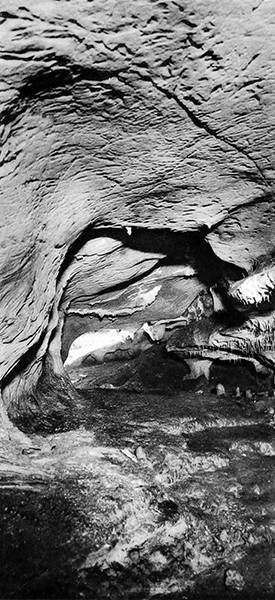
Plate I.
The end of Gallery A.
Photo: Obermaier, in Breuil et al. (1913)
Figures on the walls of Gallery A from La Pasiega.
Photo and text: Breuil et al. (1913)
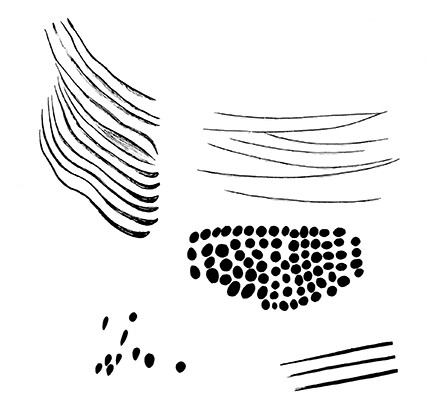
Various signs:
1 bright purplish hue, located above the abyss, at no. 66.
2 parallel engraved lines, at no. 66.
3 group of red spots, at no. 46.
4 small group of red spots, at no. 48.
5 triple horizontal line at no. 60 of the plan.
Photo and text: Breuil et al. (1913)
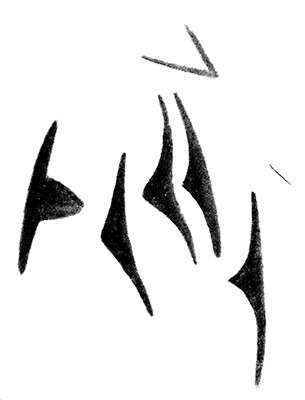
A group of large red claviform signs, situated at no. 58 on the plan, on the ceiling of a small chamber.
( note the striking resemblance to the venus figure engravings of Lalinde and Gönnersdorf, see below - Don )
Photo and text: Breuil et al. (1913)
Engravings in the Lalinde style from la Roche de Lalinde, which bear a strking resemblance to the claviform signs of Pasiega Cave shown above.
Photo: Don Hitchcock 2014
Source: Original, Musée National de Préhistoire, Les Eyzies
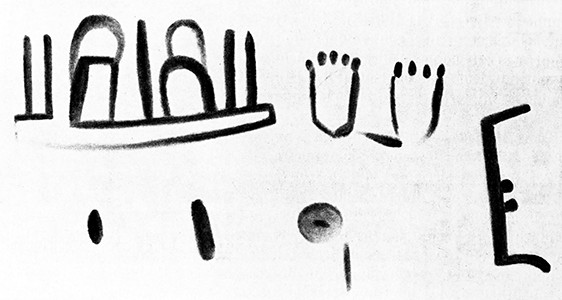
Red symbols situated 4 metres above ground level, at no. 49 on the plan.
It is a strange and incomprehensible thing that these mysterious characters have been drawn so high, in a place not very easy to access,
and in a place that we would not easily discover.
So often we can observe the search for small secluded recesses as narrow and out of the way as possible, as here. It must be said however, that the artist nevertheless had the wish to display these mysterious figures. It does not enter into our minds to seek to penetrate their meaning. We will only describe them simply, in a few words.
In the lower region, some irregularly arranged small lines and spots. On the right, a design similar to a capital E, but with a doubled small central bar. E-shaped figures are quite common on the coloured pebbles of Mas-d'Azil; we can also discover them on the ceiling of Altamira, but in black. In the upper region, two human feet on the right, with outlines drawn roughly and schematically, with one having four, the other five toes. A line joins the two heels.
On the left, a figure very similar to certain tectiforms of Font-de-Gaume; there is the parallel line of a double floor, the single central stake, the side walls formed of two vertical lines; the arched doors, surmounted by a second arch, are barely different from those of Font de Gaume with an arch made of a double line. Only the roof is completely missing, and that voluntarily.
In Marsoulas, too, there exists, in a panel rich in mysterious signs, tectiforms with and without roofs. Why this omission? This is a mystery that we will not attempt to solve.
The inscription is certainly there, but it will never tell anyone its secret - a sign of prohibition, perhaps, with regard to the layman on the threshold of the sanctuary reserved for the initiates? We are unlikely to find out.
Photo and text: Breuil et al. (1913)
Signs and colour spots, as depicted in Breuil's sketches, above.
( I try very hard not to publish my own judgements of the meanings of the artwork of the Palaeolithic, nor to assign anything but obvious interpretations. We do not know nearly enough about their cultures to make this a valid exercise.
However I confess that to me these signs are tantalisingly similar to writing symbols arranged in a purposeful manner. The meaning of this group may be greater than the sum of its individual parts - Don )
Photo: Heinrich Wendel (© The Wendel Collection, Neanderthal Museum)
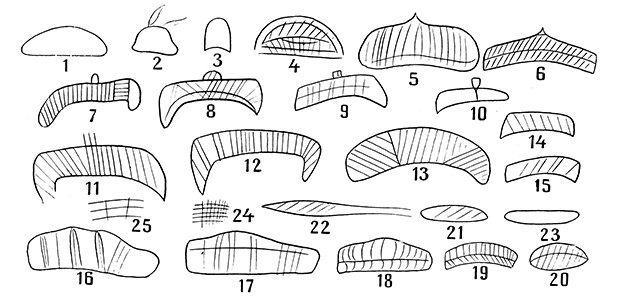
Sketches of the main types of Tectiformes of La Pasiega, grouped for their systematic study.
Older series: 1 to 3.
Primitive and shield shaped types: 4 to 25, second series.
Photo and text: Breuil et al. (1913)
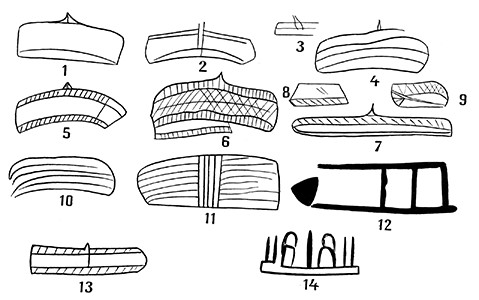
Sketches of the more advanced Tectiforms of La Pasiega for their systematic study.
( note that the ladder shaped number 12, in red, from Salle XI, was at one time believed to have been painted by Neanderthals, though that result has been shown to be unwarranted - Don )
Photo and text: Breuil et al. (1913)

Gallery B.
Early Magdalenian drawing showing a doe and a caprid (goat), situated at location 57.
( note also the distinctive dorsal outline of a mammoth at the top left - Don )
Photo and text: Breuil et al. (1913)
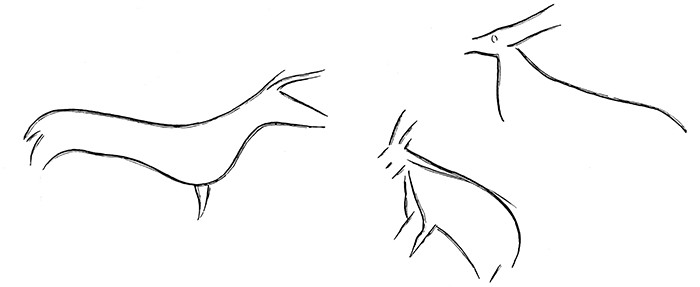
Gallery B.
Small drawings at locations 45 and 57.
( possibly a doe on the left and ibex on the right - Don )
Photo and text: Breuil et al. (1913)
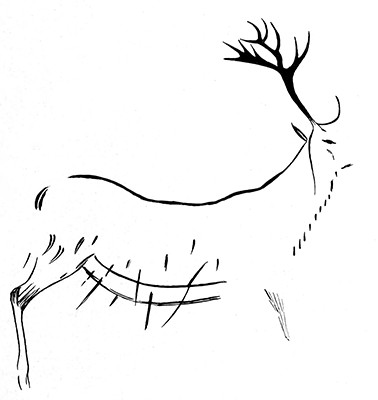
Gallery B.
Black deer, incompletely conserved, situated at position 59 of the complete plan of the drawings of La Pasiega.
Photo and text: Breuil et al. (1913)
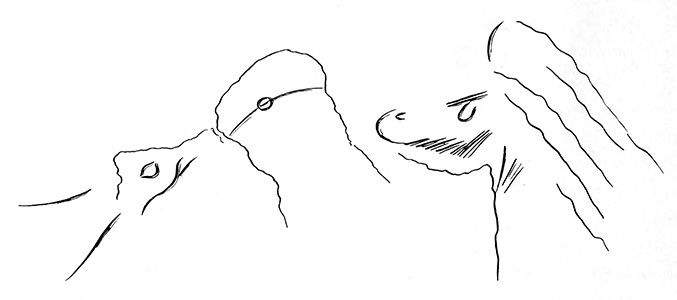
Gallery B.
Eyes engraved here and there near accidental marks on a rough and cracked wall, at no. 57 of the plan transform these accidents into figures. The one on the right is certainly a horse, the sinuous lines are natural.
Photo and text: Breuil et al. (1913)
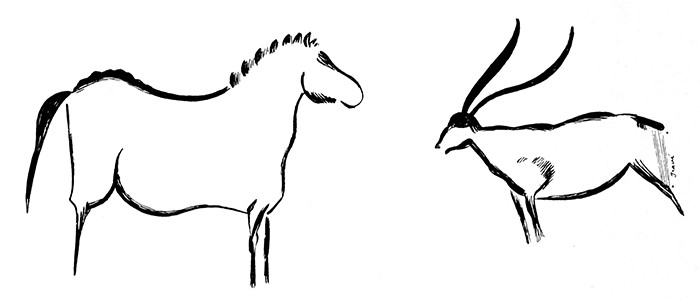
Gallery B.
Small horse painted in red (no. 50 on the plan) and an ibex of the same colour, with the haunches engraved (no. 47 on the plan)
Photo and text: Breuil et al. (1913)
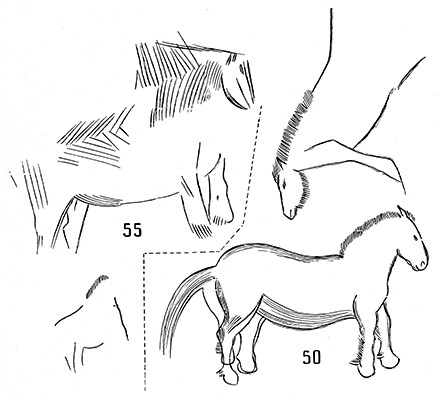
Gallery B.
Small engraved horses, at nos. 50 and 55 on the plan.
Photo and text: Breuil et al. (1913)
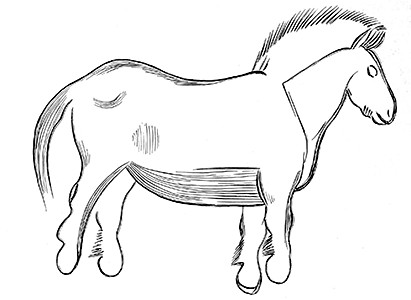
Gallery B.
Small engraved horse, no. 50 on the plan.
( Thus there are three different engravings/paintings of horses, all numbered as number 50 in the text - Don )
Photo and text: Breuil et al. (1913)
Gallery C consists of Salles VII, VIII, IX, X and XI.

Red scalariform (ladder shaped) sign, panel 78 in Salle XI of La Pasiega gallery C. This panel features the La Trampa pictorial group (21).
Photo: Hoffmann (2018)
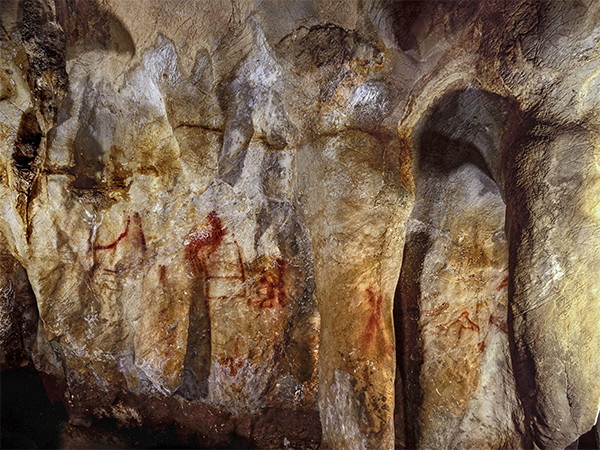
This excellent photo shows the scalariform sign in its local environment, thought by Hoffmann (2018) to be by Neanderthals, but the methods used for determining the age have been discredited by White et al. (2019)
Photo: http://wksu.org/post/cave-art-may-have-been-handiwork-neanderthals
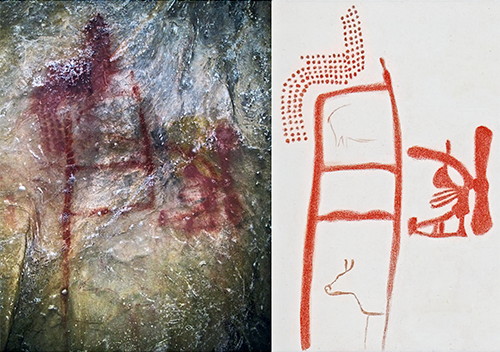
La Pasiega C, rectangular, scalariform motif with incomplete zoomorphs and red dots on Panel 78.
(left) Photo of the motif.
(right) Drawing by Breuil.
Photo and text: Hoffmann et al. (2018)
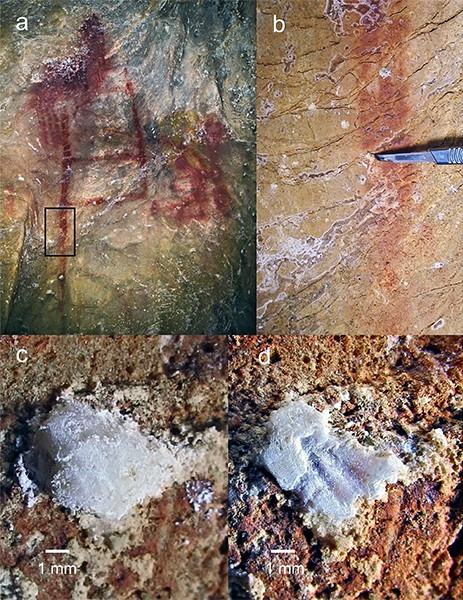
Sampling details for PAS 34.
(a) Scalariform motif; the black rectangle denotes the area enlarged in (b).
(b) The scalpel points onto the carbonate crust before sampling.
(c) The carbonate crust after the surface was scraped for initial cleaning.
(d) The carbonate crust after sampling, red pigment is visible in the centre, clearly underlying the remaining carbonate.
Photo and text: Hoffmann et al. (2018)
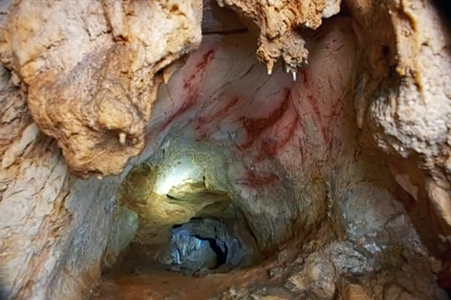
La Pasiega Cave, Cantabria.
Highly stylised Magdalenian claviforms in the parietal art of Western Europe. Female symbols in caves, both the vulvae and the claviforms, tend to be located at smaller natural cavities or 'windows'.
Photo: Martin Frouz
Photo and text: Svoboda (2008)
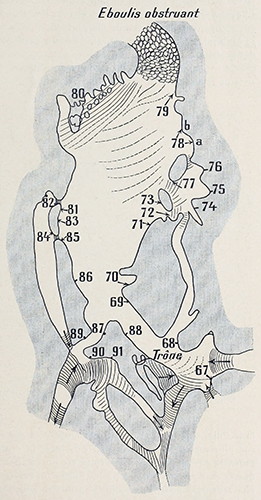
Gallery C.
Plan of Salle XI, principal location of the wall paintings in Gallery C, with details of the positions of the panels.
Photo and text: Breuil et al. (1913)
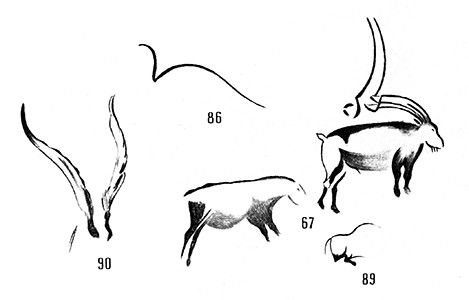
Gallery C.
Black paintings from Gallery C, representing:
90: the horns of an ibex.
86: the dorsal line of a mammoth (?)
89: a small bison.
67: a group of ibex, the rightmost of which has undergone the curious addition of a second ibex head looked at from behind, and using the horns of the first as a neck.
Photo and text: Breuil et al. (1913)
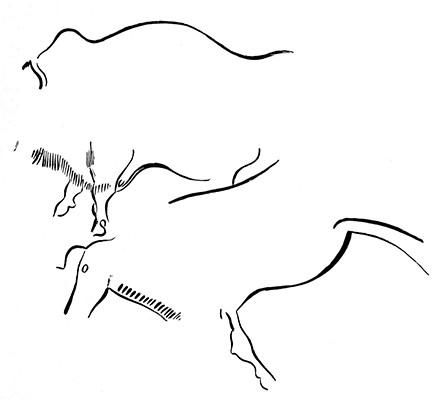
Gallery C.
Black paintings from Gallery C, representing a bison and aurochs, no. 88 from the plan.
Photo and text: Breuil et al. (1913)
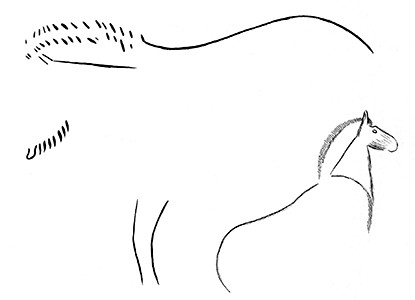
Gallery C.
Horse outlined in black, with another finely engraved, number 70 on the plan.
Photo and text: Breuil et al. (1913)
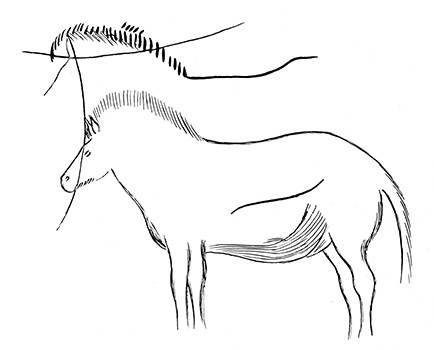
Gallery C.
Engravings and black, incomplete lines depict horses, at no. 69, not marked on the plan.
Photo and text: Breuil et al. (1913)
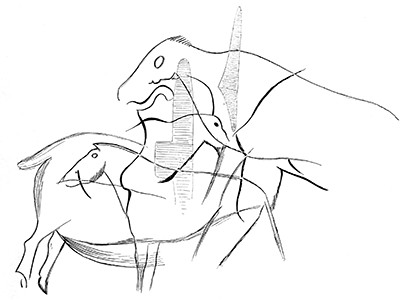
Gallery C.
Complex panel, engraved and painted, number 86 on the plan. The red claviform signs (horizontally striated) are the oldest; the black outlines overlay these, and are themselves intersected by engravings.
Photo and text: Breuil et al. (1913)
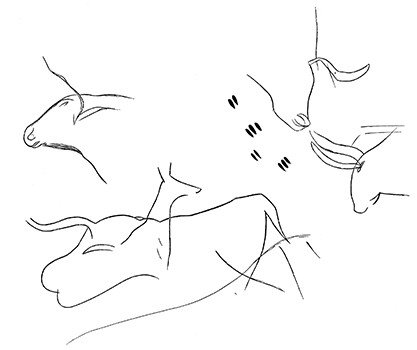
Gallery C.
Panel of engravings, Aurignacian in character, located at 61 and 62 on the plan in Salle VII, located between Gallery A and Gallery C, but nominally attributed to Gallery C. They are accompanied by some red dots.
Photo and text: Breuil et al. (1913)
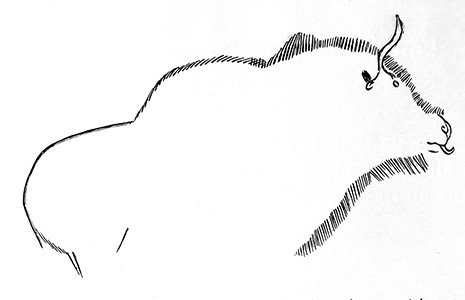
Gallery C.
Bison engraved in the upper Aurignacian style, located at 88 on the plan.
Photo and text: Breuil et al. (1913)
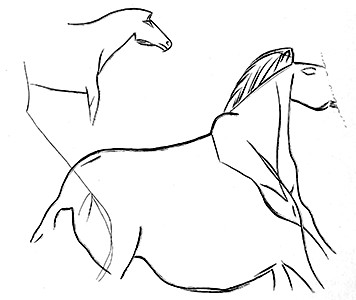
Gallery C.
Engraved horses recalling the Aurignacian engravings of the cave of Hornos de la Pena. Situated at 63 on the plan.
Photo and text: Breuil et al. (1913)
Plates
Plate II.
Red or yellow horses distributed at various points of Galleries A and C.
Photo and text: Breuil et al. (1913)
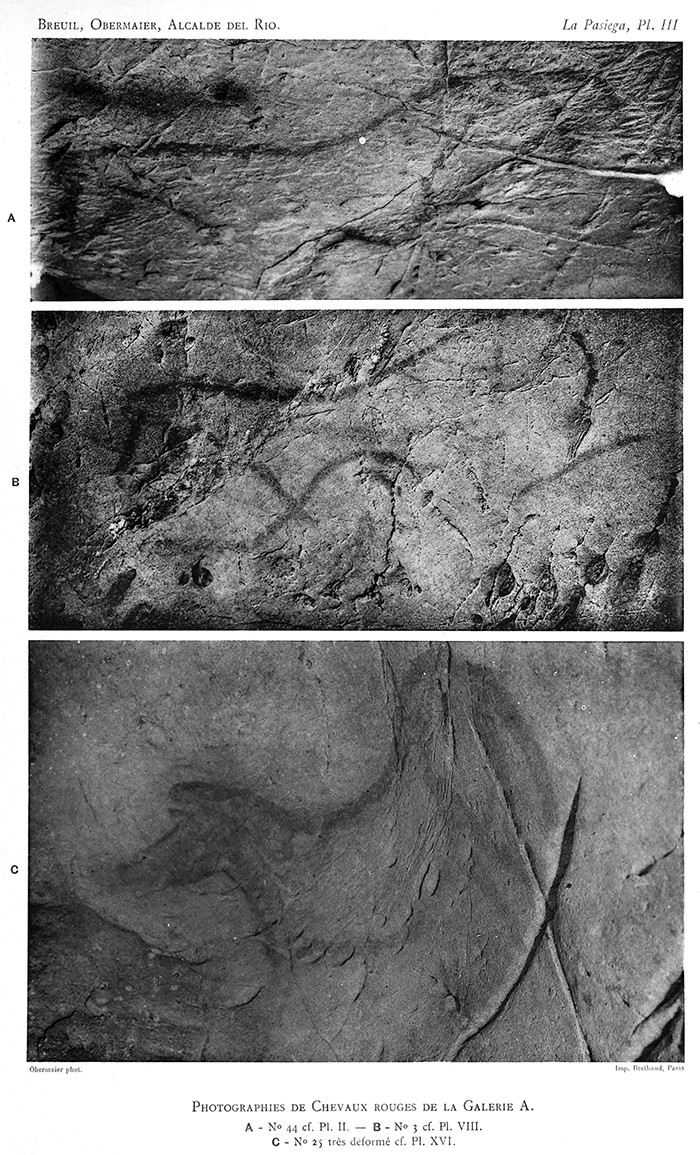
Plate III.
Red horses from Gallery A.
A - No 44 cf. Pl II.
B - No 3 cf. Pl VIII.
C - No 25 very deformed cf. Pl XVI.
Photo and text: Breuil et al. (1913)
Plate IV.
Panel of does in plain red, and doe No 4.
Photo and text: Breuil et al. (1913)
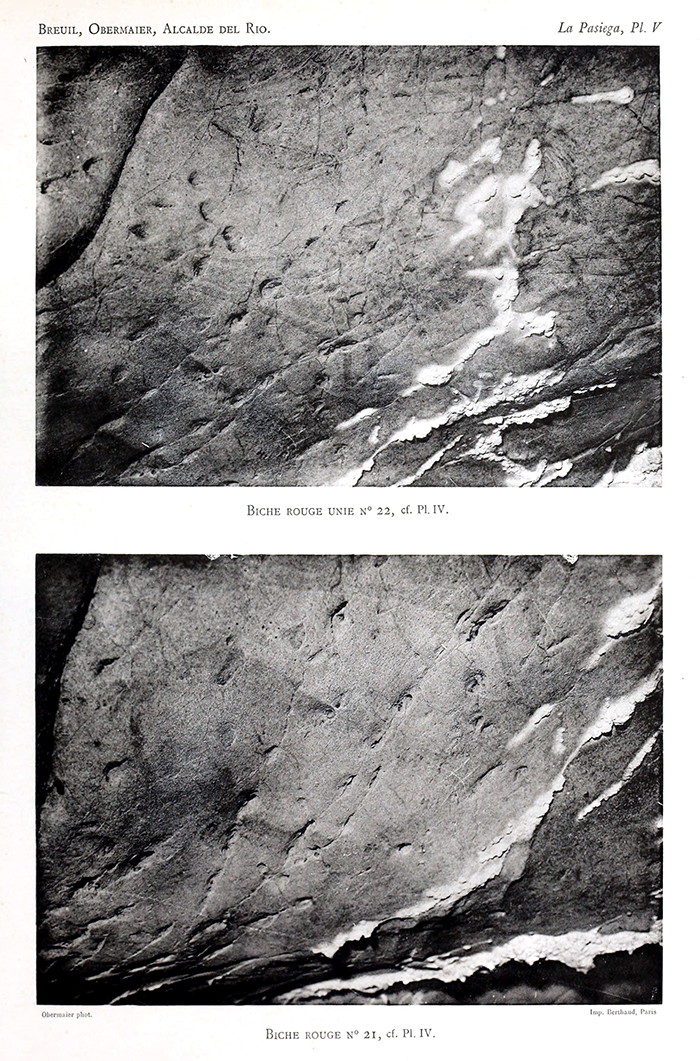
Plate V.
Top - Plain red doe No 22, cf. Pl. IV.
Bottom - Red doe No 21, cf. Pl. IV.
Photo and text: Breuil et al. (1913)
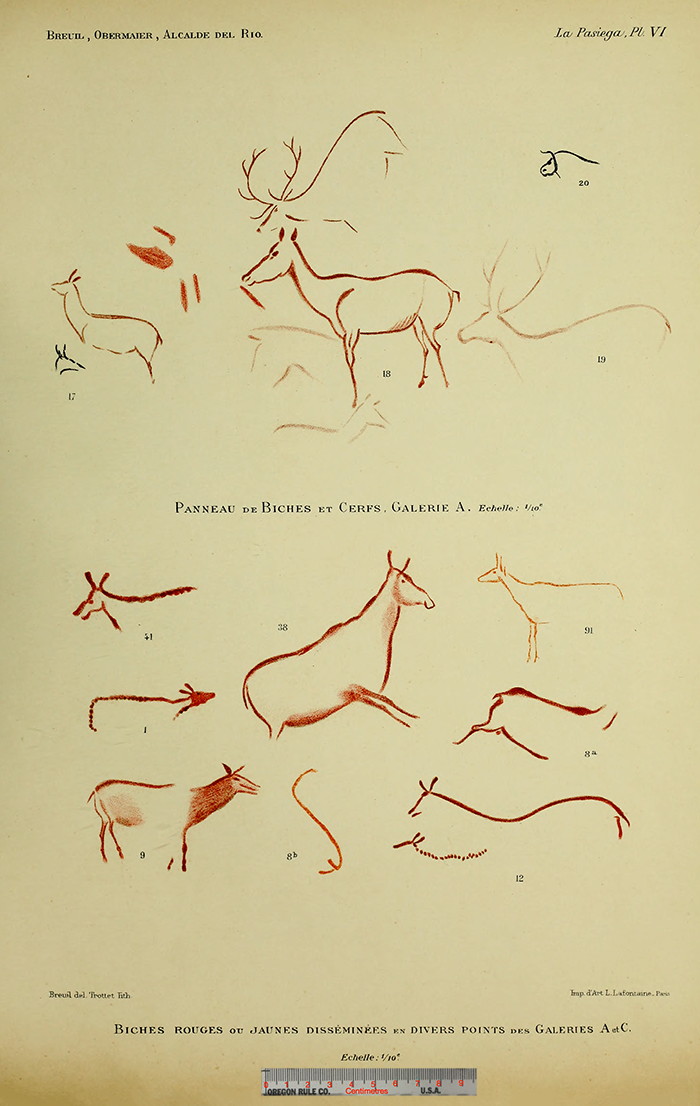
Plate VI.
Top - Panel of does and deer, Gallery A.
Bottom - Red or yellow does distributed at various points of Galleries A and C.
Photo and text: Breuil et al. (1913)

Plate VII.
Top left - Red doe No 24, cf. Pl. XVI.
Top right - Red Deer and red doe No 18.
Bottom - Red doe No 18, cf. Pl. VI.
Photo and text: Breuil et al. (1913)
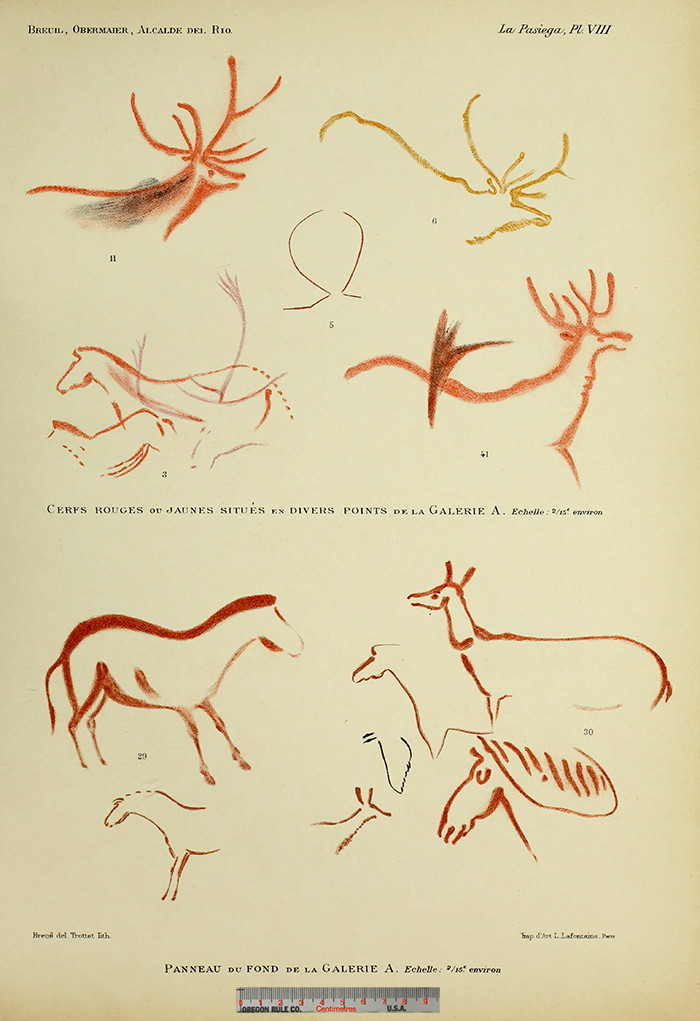
Plate VIII.
Top - Red and yellow deer situated at various points of Gallery A.
Bottom - Panel at the end of Gallery A.
Photo and text: Breuil et al. (1913)
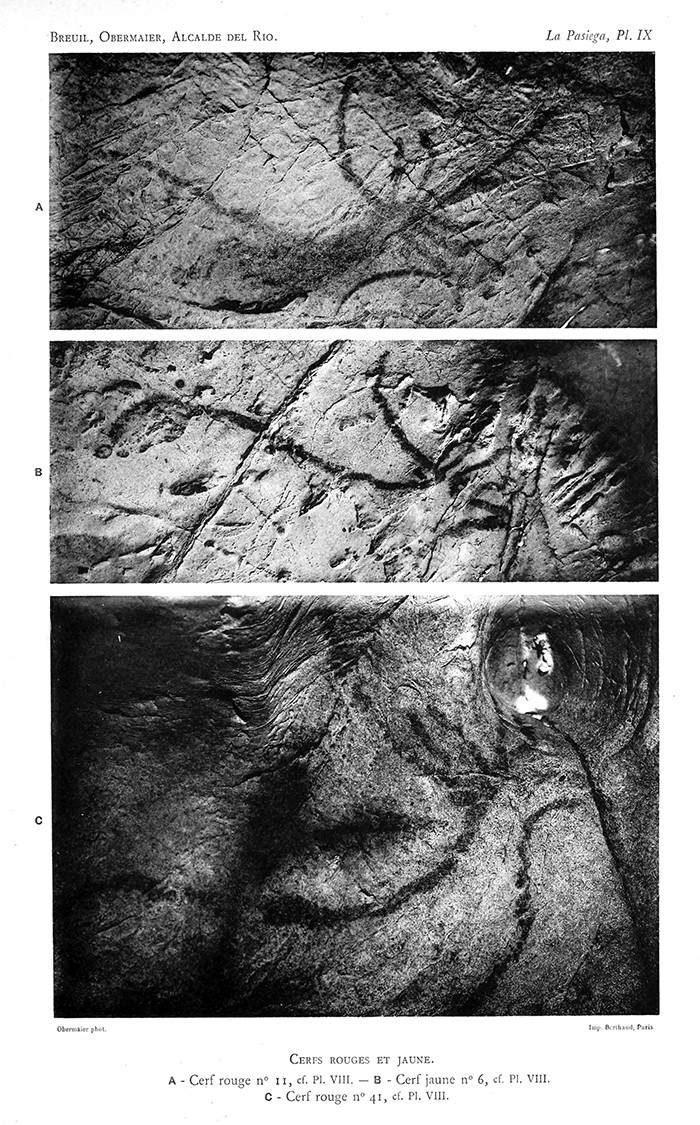
Plate IX.
Red and yellow deer.
A - Red deer no 11, cf. Pl. VIII.
B - Yellow deer no. 6, cf. Pl. VIII.
C - Red deer no. 41, cf. Pl. VIII.
Photo and text: Breuil et al. (1913)
Plate X.
Tectiform signs from Gallery A.
Photo and text: Breuil et al. (1913)
Plate XI.
Panels Nos 34, 35, with animals and tectiforms, red or brown.
Photo and text: Breuil et al. (1913)
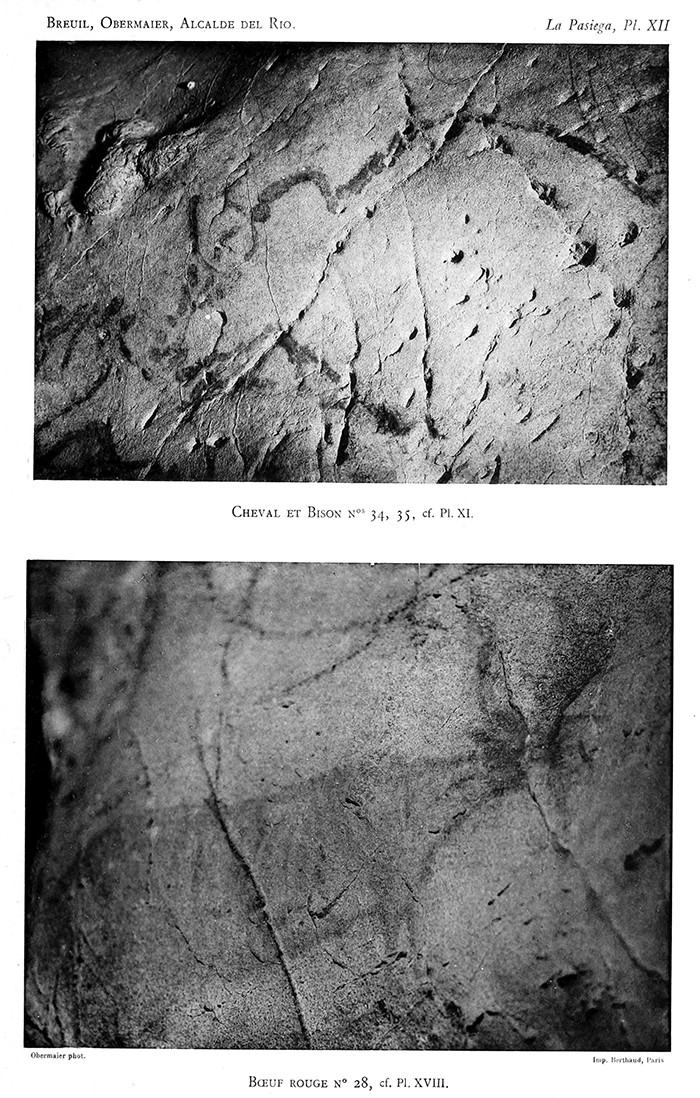
Plate XII.
Top - Horse and bison, Nos 34, 35, cf. Pl. XI.
Bottom - Red bull no. 28, cf. Pl. VIIII.
Photo and text: Breuil et al. (1913)
Plate XIII.
Chamois, deer, horse and red tectiforms from Gallery A.
Photo and text: Breuil et al. (1913)
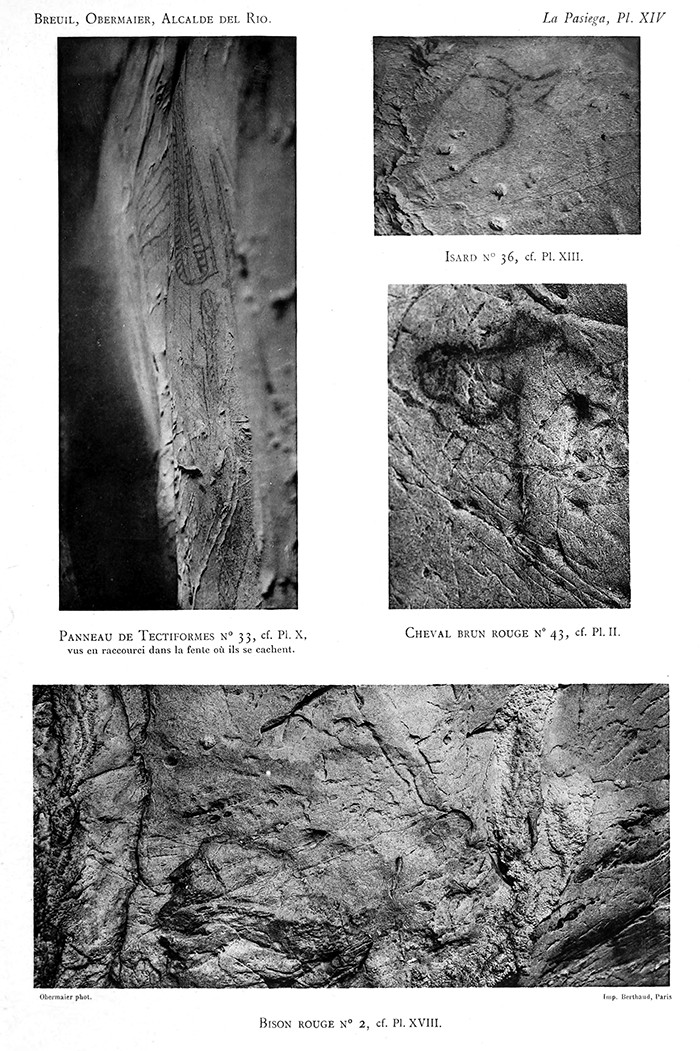
Plate XIV.
Left top - Panel of tectiforms No 33, cf. Pl X, seen in a recess in which they lie hidden.
Right top - Chamois No 36, cf. Pl. XIII.
Right lower - Reddish brown horse No 43, cf. Pl. II.
Bottom - Red bull no. 2, cf. Pl. XVIIII.
Photo and text: Breuil et al. (1913)
Plate XV.
Deer, Bison and tectiforms from Gallery A.
Photo and text: Breuil et al. (1913)
Plate XVI.
Horses, does, and bison from Gallery A.
Photo and text: Breuil et al. (1913)
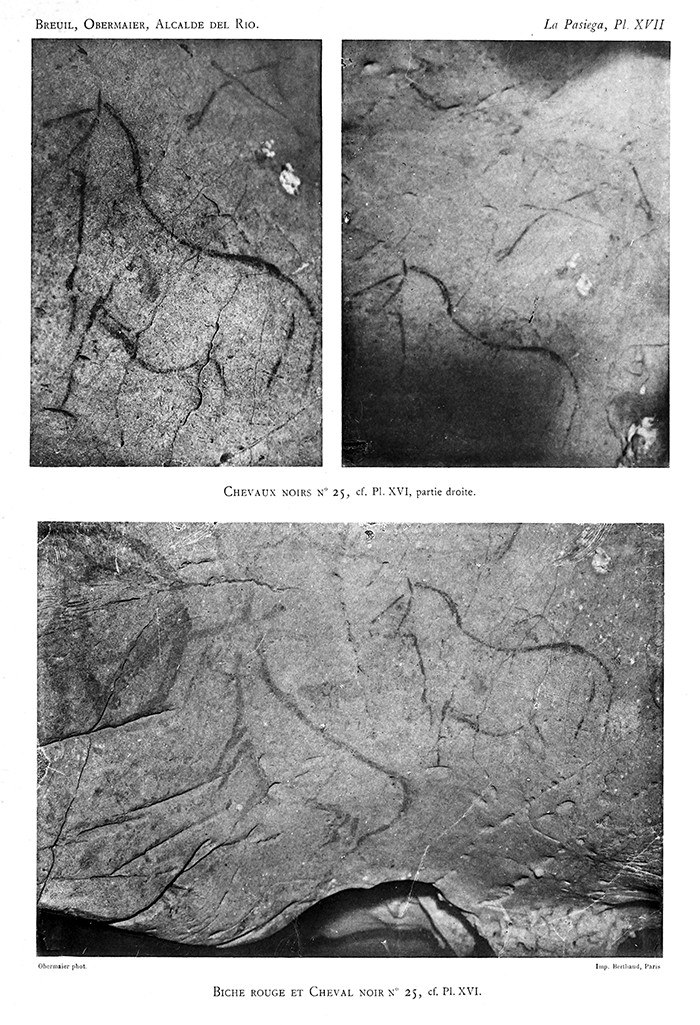
Plate XVII.
Top - Black horses No 25, cf. Pl XVI, right section.
Bottom - Red doe and black horse No. 25, cf. Pl. XVI.
Photo and text: Breuil et al. (1913)
Plate XVIIII.
Bulls, bisons etc., distributed between Galleries A and C.
Photo and text: Breuil et al. (1913)

Plate XIX.
Red horse and bisons Nos. 51 and 53, Gallery B.
Photo and text: Breuil et al. (1913)
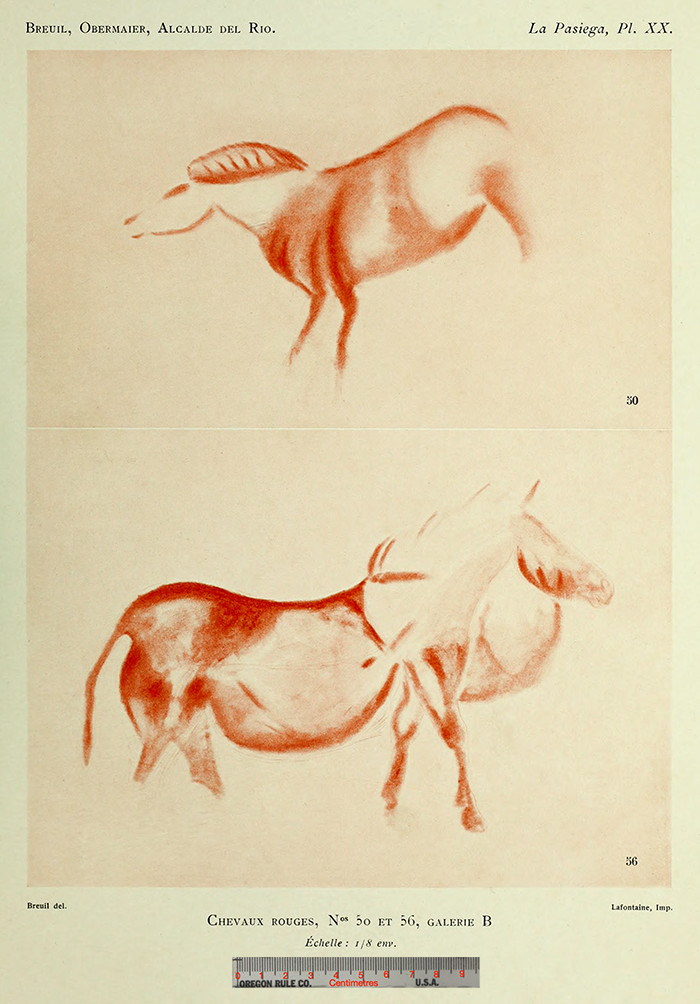
Plate XX.
Red horses, Nos. 50 and 56, Gallery B.
Photo and text: Breuil et al. (1913)
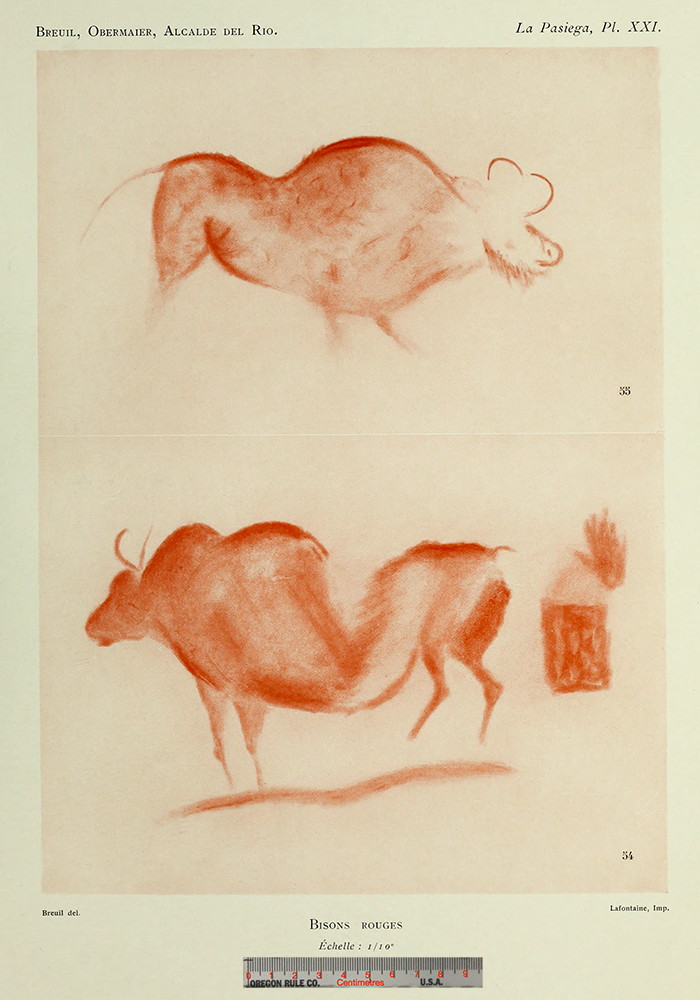
Plate XXI.
Red bison.
Photo and text: Breuil et al. (1913)
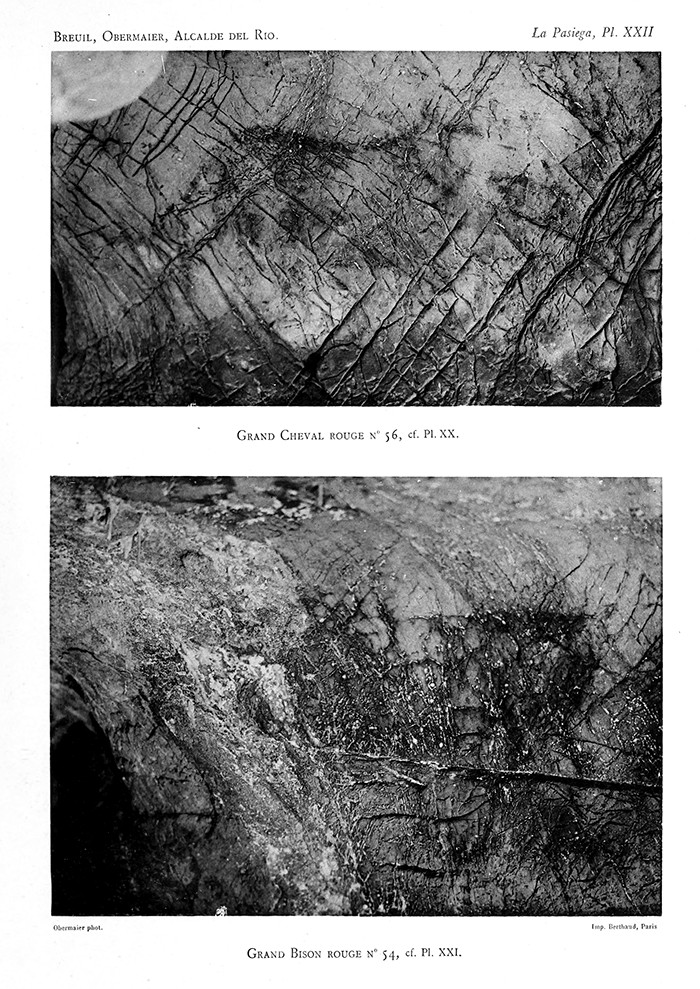
Plate XXII.
Above - Large red horse No. 56, cf. Pl. XX.
Below - Large red bison No. 54, cf. Pl. XXI.
Photo and text: Breuil et al. (1913)
Plate XXIII.
Signs and animals of Salle XI.
Photo and text: Breuil et al. (1913)

Plate XXIV.
Above - Symbolic inscription in red, No. 49 from Gallery B, cf. fig.20.
Below (left) - Rock formation in the form of a throne, from Salle XI.
Below (right) - Anthropomorphic head in red crowned by the horns of a bison, no. 77, cf. Pl. XXIII.
Photo and text: Breuil et al. (1913)
Plate XXV.
Complex panel from Salle XI, with signs and animals.
Photo and text: Breuil et al. (1913)
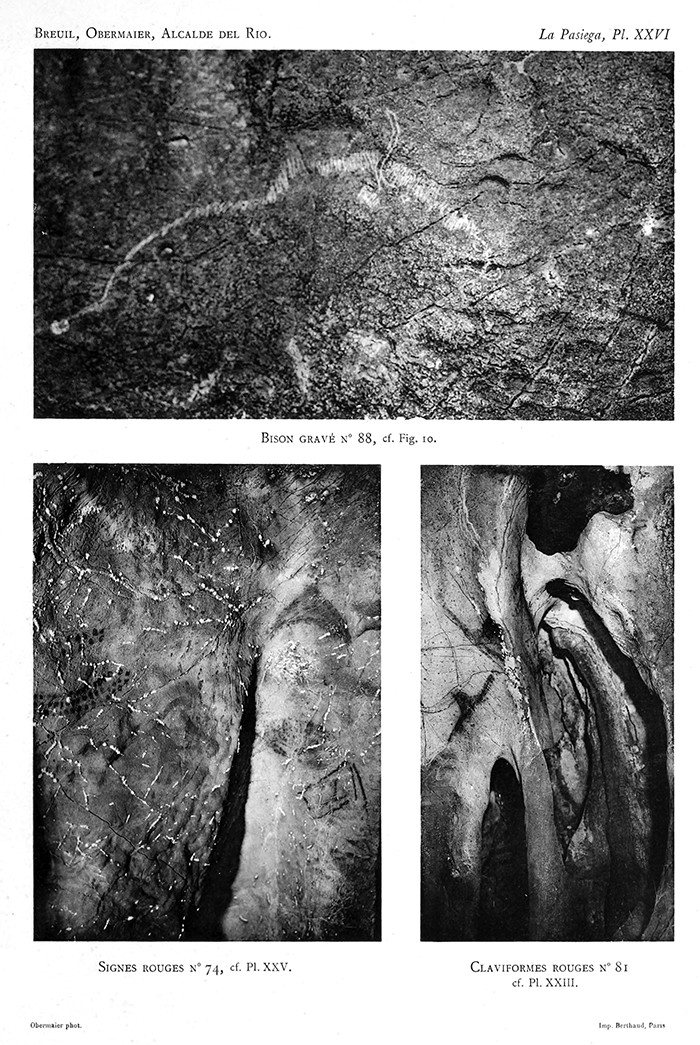
Plate XXVI.
Above - Engraved bison No. 88, cf. fig. 10.
Below (left) - Red signs No. 74, cf. Pl XXV.
Below (right) - Red claviforms no. 81, cf. Pl. XXIII.
Photo and text: Breuil et al. (1913)
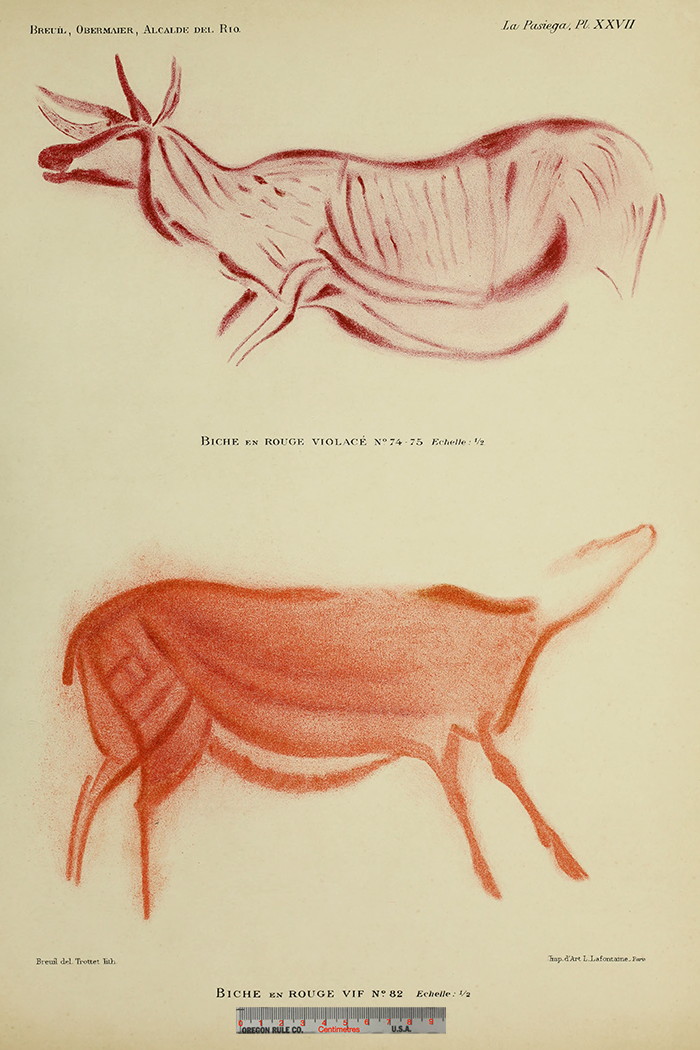
Plate XXVII.
Above - Reddish violet doe No. 74 - 75.
Below - Bright red doe No. 82.
Photo and text: Breuil et al. (1913)
Plate XXVIII.
Left - red does obliterated by black drawings restored to polychrome figures.
Right - Brown bison subsequently restored with black.
Photo and text: Breuil et al. (1913)
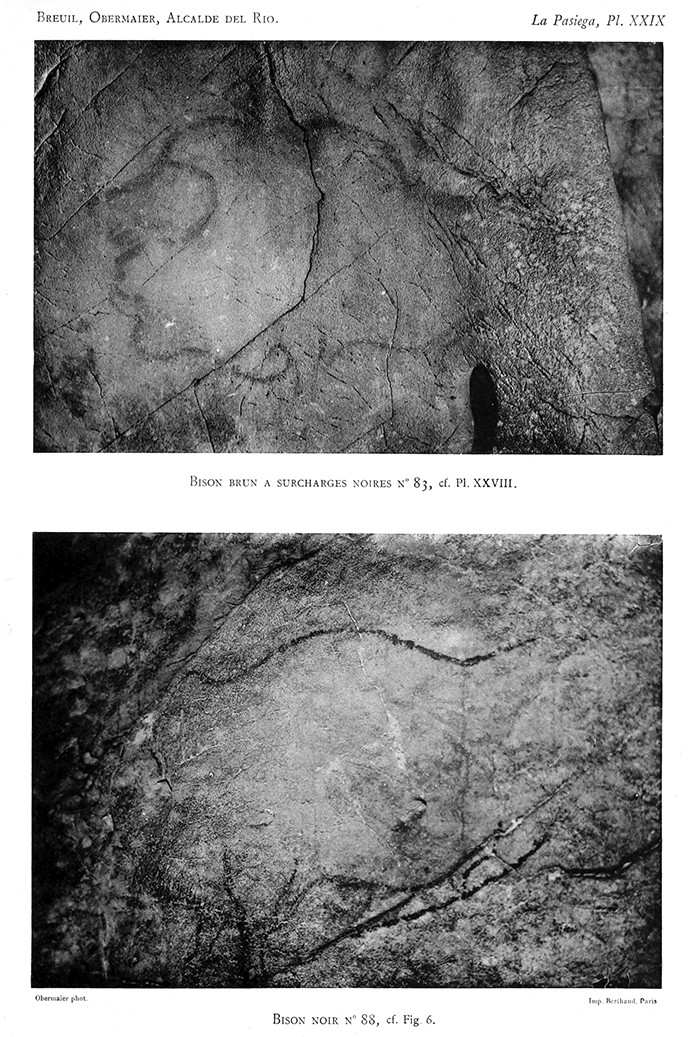
Plate XXIX.
Above - Brown bison restored with black, No. 83, cf. Pl. XXVIII.
Below - Black bison No. 88, cf. Fig. 6.
Photo and text: Breuil et al. (1913)
References
- Alcalde del Rio H., Breuil H. & Sierra L., 1912: Les cavernes de la région cantabrique, Monaco, Vve A. Chêne, 265 p.
- Breuil, H., Obermaier, H., Alcalde Del Rio, H., 1913: La Pasiega à Puente-Viesgo (Santander) (Espagne), Imprimerie Artistique Vve A. Chêne, 1913
- Breuil, H., 1921: Nouvelles cavernes ornées paleolithiques dans la province de Málaga, L'Anthropology, T. XXXI, no. 34. Paris.
- Cantalejo P., Ramos J., Weniger G., Kehl M., del Mar Espejo M., 2014: Cueva de Ardales, Province of Malaga, Southern Mediterranean Coast, Guadalquivir River and Betic Intramontane Basins, Pleistocene and Holocene Hunter-Gatherers in Iberia and the Gibraltar Strait: The Current Archaeological Record, Universidad de Burgos 2014
- Dickson M., 1915: The American Museum Journal, Volume XV, 1915, NYC.
- Hoffmann, D., et al., 2018: U-Th dating of carbonate crusts reveals Neandertal origin of Iberian cave art, Science, 359 (6378), 912-915. DOI: 10.1126/science.aap7778, pp. 912–915 (2018) 23 February 2018
- Svoboda J., 2008: Upper Paleolithic female figurines of Northern Eurasia. In: J Svoboda, ed., PETRKOVICE. The Dolní Věstonice Studies 15, Brno 2008, 193-223.
- White, R., et al., 2019: Still no archaeological evidence that Neanderthals created Iberian cave art, Journal of Human Evolution, https://doi.org/10.1016/j.jhevol.2019.102640
